
Vietnam is a country that grabs hold of all the senses from the get-go: the hum of scooters weaving through busy streets, the scent of street food sizzling, the colonial facades standing alongside modern glass towers. It’s a place where history and progress coexist, from the ancient temples of Hanoi to the buzzing nightlife of Saigon. Whether exploring timeworn alleyways, gliding through emerald waters, or indulging in the country’s legendary cuisine, every moment here feels alive with energy and tradition.
Overview of our trip
Our journey took us from Hanoi, where the Old Quarter’s narrow streets and Hoan Kiem Lake’s tranquil beauty introduced us to the city’s contrasts. We then cruised through the dramatic limestone karsts of Halong Bay, before flying south to Hoi An, a town of lantern-lit streets, tailor shops and riverside charm. In Saigon, we embraced the city’s fast-paced rhythm, exploring grand colonial landmarks, rooftop bars and its wartime history. Finally, we wound down at Six Senses Ninh Van Bay, a secluded paradise where we traded city chaos for ocean views and jungle serenity.
We travelled in February which was, on paper, a month which should have had plenty of sunshine and blue sky. However, as if often the case now, the weather was not as expected. We had a lot of grey skies and some rain, although we were delighted when the sun finally came out for our last two days by the beach in Nin Vanh Bay!
As with all our curated trips, the places we write about here were selected based on lots of research, using luxury travel magazines like Condé Nast Traveller plus recommendations from friends who knew the cities well.
Overnight: Fly London to Hanoi
Day 1: Arrive Hanoi, stay Capella (2 nights)
Day 3: Drive to Halong Bay, cruise on Ginger by Heritage Line (1 night)
Day 4: Drive back to Hanoi, fly to Da Nang, car transfer drive to Hoi An, stay Four Seasons (3 nights)
Day 7: Fly Da Nang to Ho Chi Minh (Saigon), stay Hotel des Arts (2 nights)
Day 9: Fly Ho Chi Minh to Can Ranh, car and boat transfer to Nin Vanh Bay, stay Six Seasons (4 nights)
Day 13: Fly Can Ranh to Ho Chi Minh then on to London (overnight)
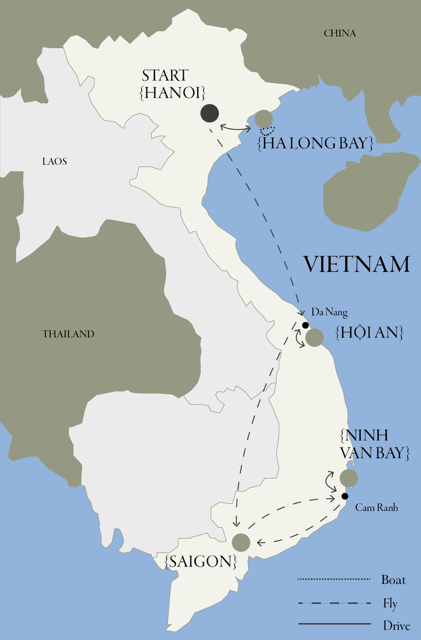
Hanoi
We started our trip with a bang in Vietnam’s northern capital. Hanoi is a truly multi-sensory experience. From the moment you arrive, the city envelops you in a whirlwind of honking motorbikes, crumbling colonial facades and the aroma of countless street food vendors. It’s a city of contrasts, where contemporary coffee shops, ancient temples and boutique hotels existing in chaotic harmony.
Stay
CAPPELLA
The Capella is well located close to Hanoi’s Old Quarter and Hoan Kiem Lake, steps from the Hanoi Opera House that inspired its designer Bill Bensley. The hotel blends vintage charm with contemporary luxury, featuring Art Deco interiors and plush. Rooms and suites are individually styled with memorabilia that pay tribute to Opera’s legendary artists, composers, designers and performances.
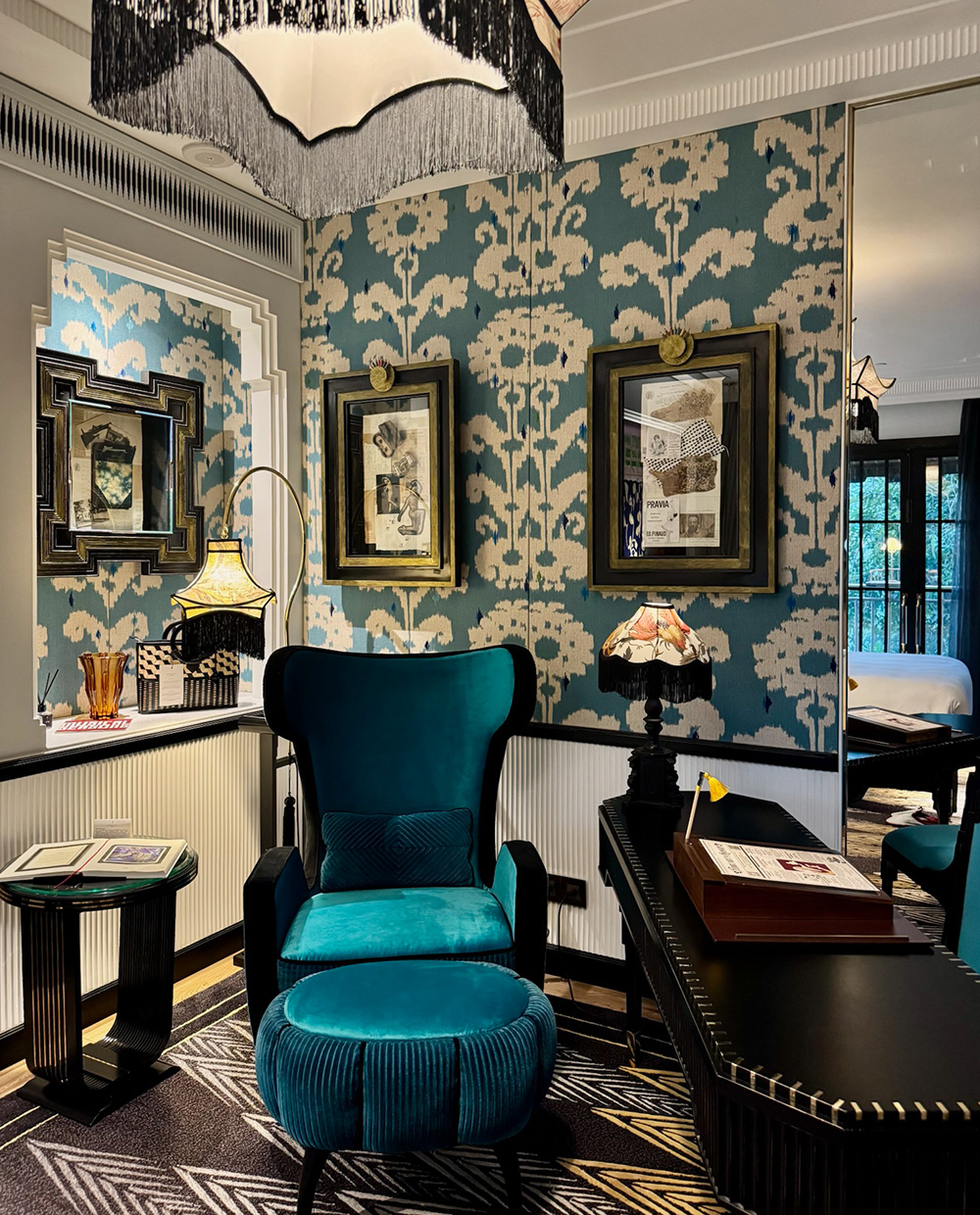
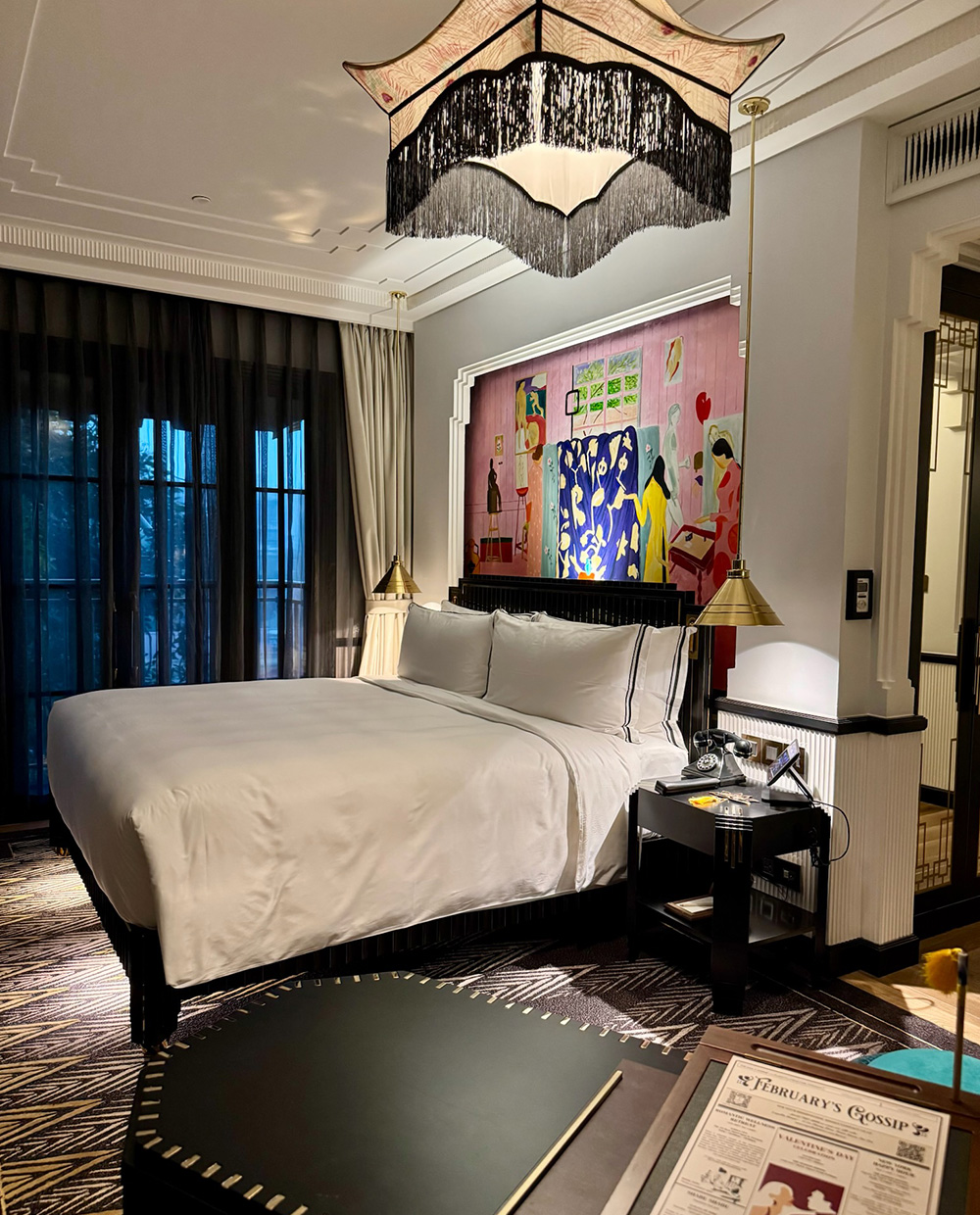
The hotel’s downstairs lounge, the Living Room serves complementary afternoon tea every day from 3-4 pm. The bar exudes old-world elegance, with velvet armchairs and gilded mirrors and art deco accents. The hotel’s signature restaurant, Backstage, continues the opera house theme, with a backdrop of murals and stunning costumes curated from opera’s greatest performances (a little over the top to our taste!). Cuisine is based on bold renditions of Northern Vietnamese cuisine, executed with modern culinary techniques.
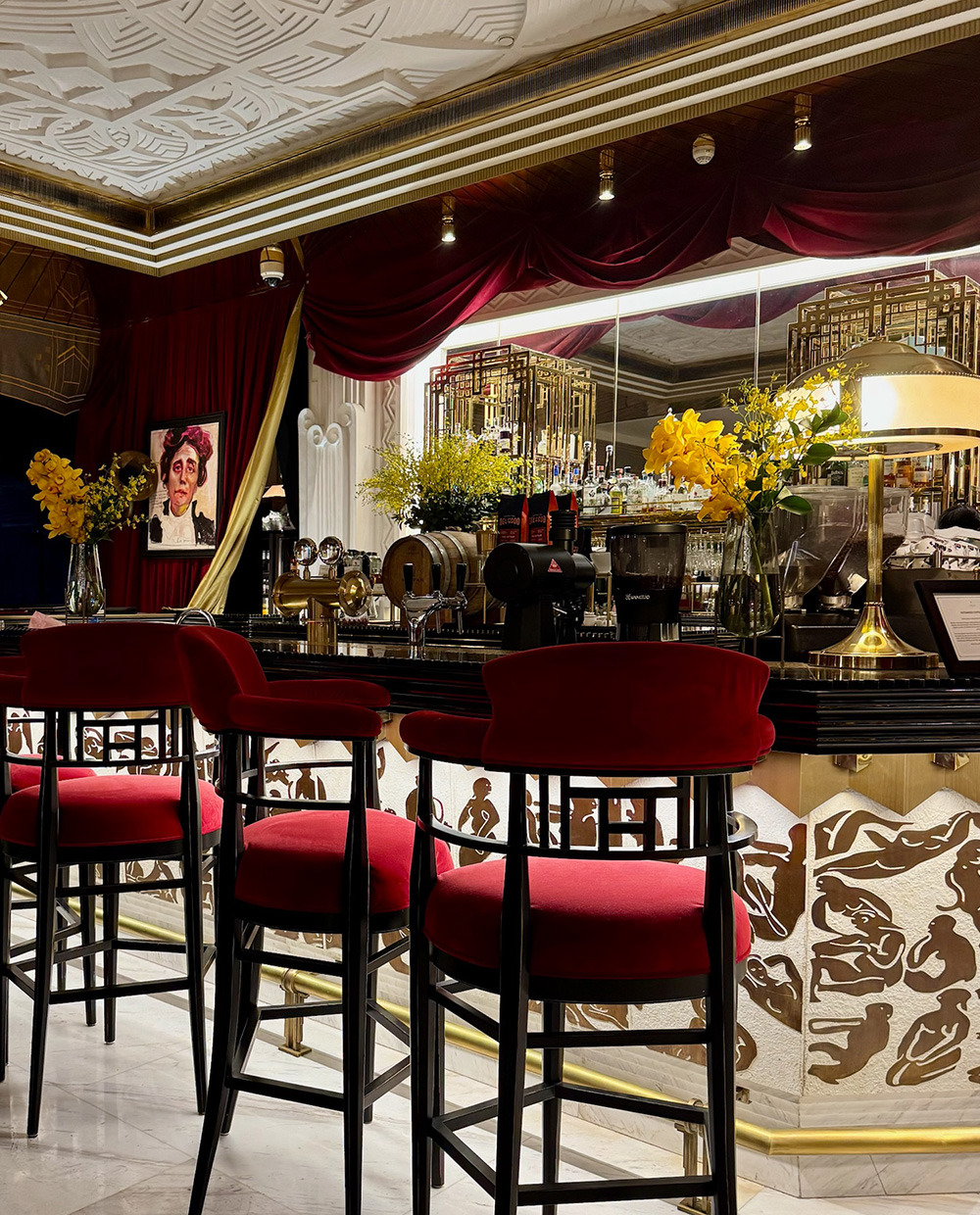

The Auriga Spa was a welcome oasis of calm, with a sauna, steam room and large mosaic-tiled pool. A range of treatments is also on offer though we ran out of time to try them!
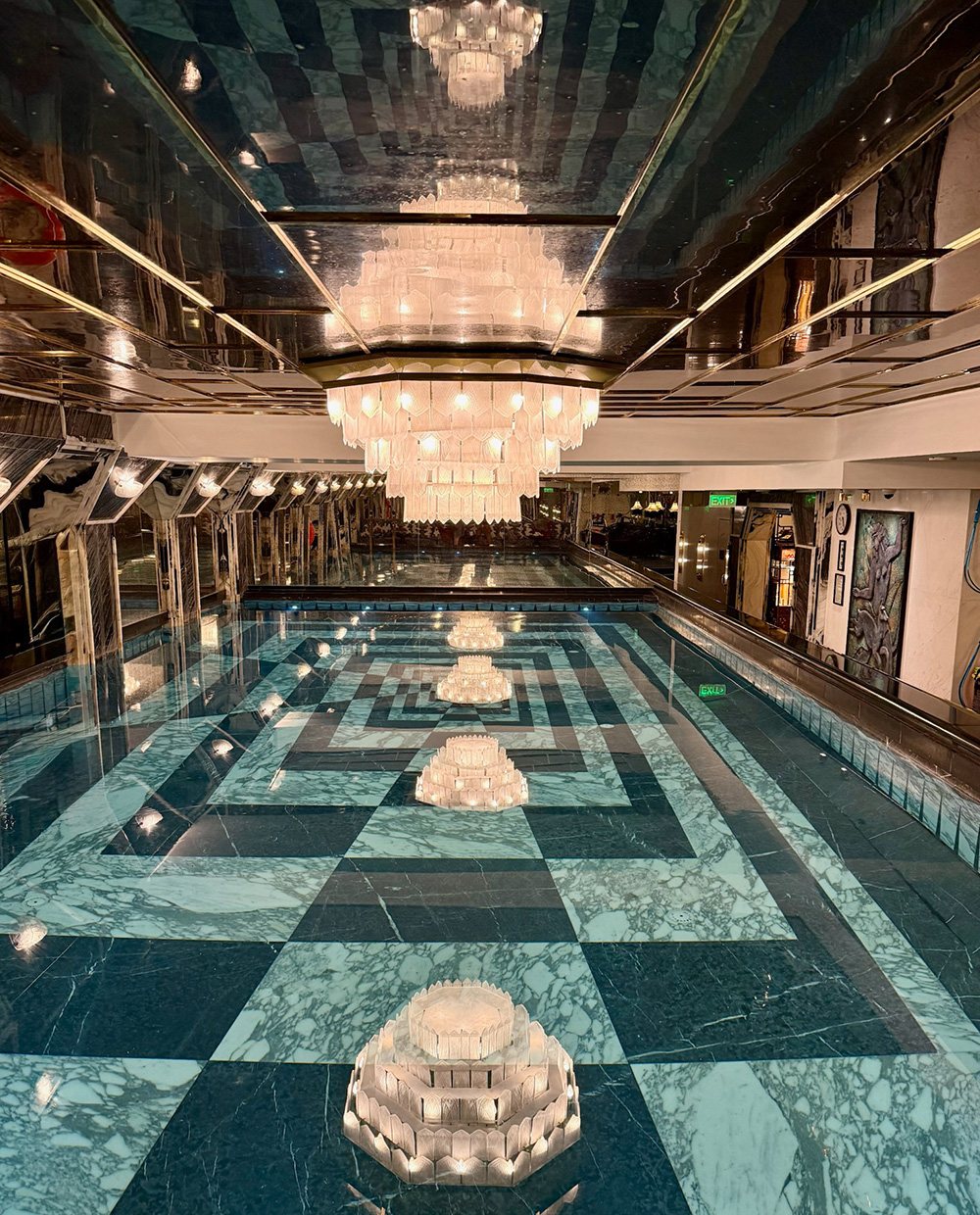
THE METROPOLE
The Sofitel Legend Metropole was the other hotel option we considered, before settling on the Capella because we felt it had a bit more character. The Metropole is an iconic hotel with a long history, having opened in 1901 and hosted many dignitaries and celebrities. It embodies the city’s colonial elegance, blending classic French sophistication with Vietnamese charm, featuring grand chandeliers, polished hardwood floors and Indochine décor.
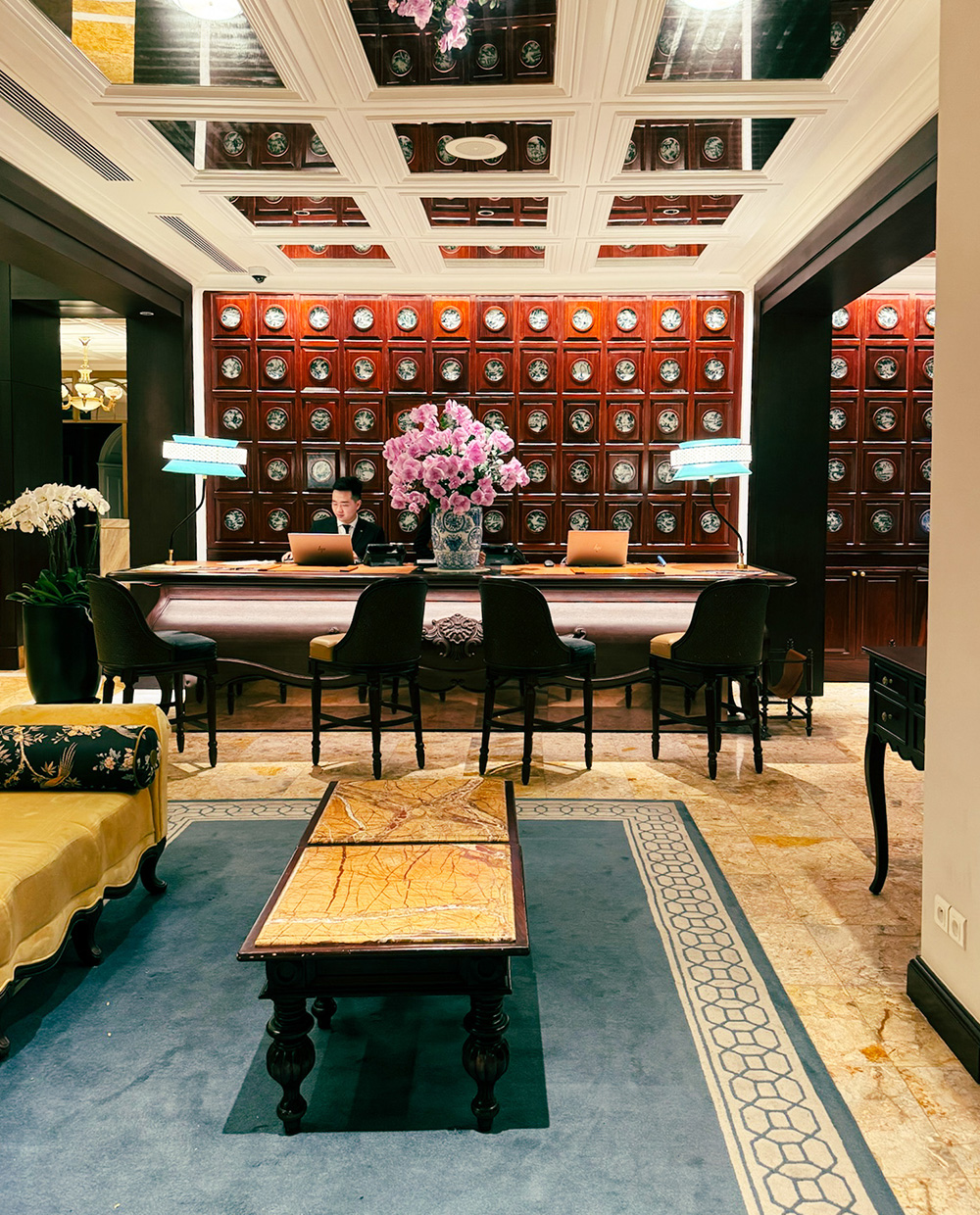

Do
OLD QUARTER
The Old Quarter is the beating heart and soul of Hanoi. This labyrinth of narrow streets is brimming with life, with vendors spilling onto the pavements selling everything from fresh fruit to hand-forged silver. The sidewalks double as kitchens, parking spaces and meeting spots, making walking an adventure in itself!



This district’s origins date back to the 11th century when guilds settled here, naming streets after on stil their trades. The tradition remains today. For example, Hang Bong is known for cotton products and tailors, Hang Ma is a riot of color, packed with paper decorations, and Hang Bac is home to Hanoi’s silversmiths. There’s no map needed here: just follow your instincts. Admire the buildings that blend crumbling colonial elegance with modern day designs, stop for a street snack and embrace the vibrant chaos of the Old Quarter!
TRAIN STREET
Imagine sipping a coffee as a thunderous train barrels past, inches from your face. That’s Train Street! Once a quiet residential track, the area has transformed into a bustling café-lined strip. As the train approaches, a warning siren sounds and a buzz of anticipation sweeps through the crowd. Locals gather their belongings, as café owners fold up chairs and usher tourists to safety. Within moments the massive locomotive hurtles through, so close you can feel its rumble in your chest. Check the up-to-date train times with your local guide or hotel concierge. Then arrive 30-45” early to bag a sat next to the track.


PHUNG HANG MURAL STREET
Phung Hang Mural Street is an artistic collaboration between Vietnamese and Korean artists that has turned railway archways into a vivid, open-air gallery. Murals bring Hanoi’s past to life: merchants in conical hats, bustling markets, and scenes of old-world charm. It was one of the favourite finds during our stay. It’s close to Train Street, so a good spot to visit after doing that.


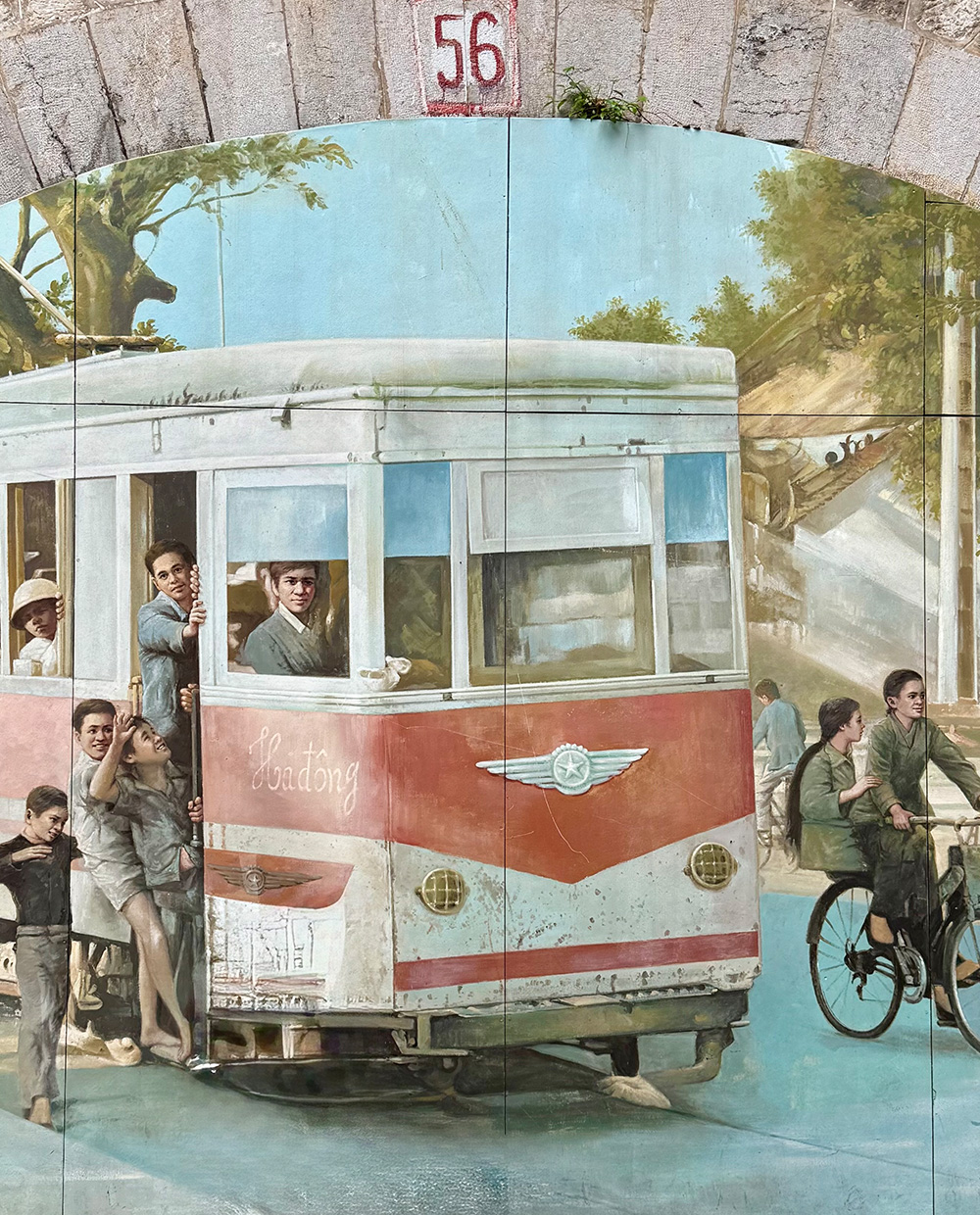
HO CHI MINH PRECINCT
Ho Chi Minh is revered as the father of modern Vietnam, celebrated for freeing the country from colonial rule and leading it to independence. Ironically, for a staunch communist who advocated for a simple, austere lifestyle, Ho Chi Minh now has this sprawling complex dedicated to celebrating his life! This reflects a broader shift in Vietnam’s approach to governance and economics. While the Communist Party still rules, the country has embraced market-driven reforms since the late 1980s.
Ho Chi Minh Mausoleum
The Ho Chi Minh Mausoleum is an imposing brutalist building and solemn tribute to “Uncle Ho”. His embalmed body lies in state, housed in a glass case; impressive but slightly creepy it has to be said! Visitors file through in hushed silence, supervised by soldiers dressed in chic white uniforms.

Presidential Palace & Stilt House
The Presidential Palace with its grand yellow facade was originally the residence of the French Governor-General of Indochina. The architectural masterpiece was offered to Ho Chi Minh upon independence in 1945. However, he turned it down on favour of the simple wooden Stilt House set amidst tranquil gardens. A peek inside reveals a space of Spartan simplicity, reflecting the leader’s ideals.
One Pillar Pagoda
Legend tells of Emperor Lý Thái Tông, who, after dreaming of the Bodhisattva Avalokiteshvara handing him a son, constructed this temple in gratitude. The One Pillar Pagoda is designed to resemble a lotus blossom emerging from the water and the original structure stood for nearly a millennium before being destroyed in 1954. It was meticulously rebuilt to mirror its initial design.

HOAN KIEM LAKE & NGOC SON TEMPLE
Beyond its beauty, Hoan Kiem Lake is a perfect place to escape the chaos of the Old Quarter. On weekends, the roads surrounding the lake are closed to traffic. This transforms the area into a lively hub with local families and tourists mingling and enjoying the open space.
Its name, “Lake of the Returned Sword,” comes from legend. Emperor Le Loi is said to have been given a mystical sword to drive out invading Chinese forces in 1428. After his victory, a golden turtle surfaced and reclaimed the blade, returning it to the lake’s depths. At the lake’s northern edge, the famed red bridge (Caầu Thê Húc) leads to Ngoc Son Temple, one of Hanoi’s most iconic landmarks. Dedicated to Vietnamese national heroes and scholars, the temple is a striking mix of scarlet doors, terracotta roofs and intricate carvings.


THE TEMPLE OF LITERATURE
A visit to the Temple of Literature takes you back to 1070, when Vietnam’s first university was founded to honour the teachings of Confucius. Set in a leafy, manicured complex, it’s a world away from Hanoi’s frenetic streets. Five courtyards unfold in perfect symmetry, each one steeped in history.
The Khue Van Cac (Pavilion of the Constellation of Literature) is a two-tiered structure, with circular windows and ornate wooden beams. It symbolizes Vietnam’s deep reverence for knowledge. Scholars once studied here in pursuit of enlightenment and names of some of them are still etched into the temple’s famous stone tablets, perched on the backs of turtle statues. Further inside, the Đại Thành Sanctuary has ten altars honouring Confucius and his most devoted disciples.
The temple is popular with tourists and also with students seeking good luck before exams or celebrating their graduation. So, be ready for crowds and queues!



Dine
BAHN MI 25
Banh Mi 25, located in the Old Quarter, is a bustling street-side eatery that is one of the most popular spots for enjoying a banh mi. These Vietnamese sandwiches consist of crispy baguettes generously filled with a variety of fillings such barbecued pork, flavoured with fresh herbs and chili sauce. What sets Banh Mi 25 apart is not just its high-quality ingredients and delicious flavours but also its friendly service and cozy ambiance.
UU DAM CHAY
Uu Dam Chay’s plant-based menu features elevated Vietnamese and fusion dishes. The multi-story villa had a striking visual design inspired by Buddhist philosophy, with exposed, bright red brick walls.



STREETFOOD TOUR
A street food tour is the perfect way to immerses yourself in Hanoi’s vibrant culinary scene. Wandering through the bustling streets of the Old Quarter, we sampled an array of food stalls and small eateries serving Hanoi’s most iconic dishes. You can organise a tour through your hotel concierge/tour operator or find one on Trip Advisor.
The first part of tour was at lunchtime, trying bún chả, a combination of grilled pork patties and white rice noodles served in a bowl of nước chaấm, a tangy fish sauce. We had ours at the Bún Chả Hàng Quạt tucked away in a narrow alley in the Old Quarter.
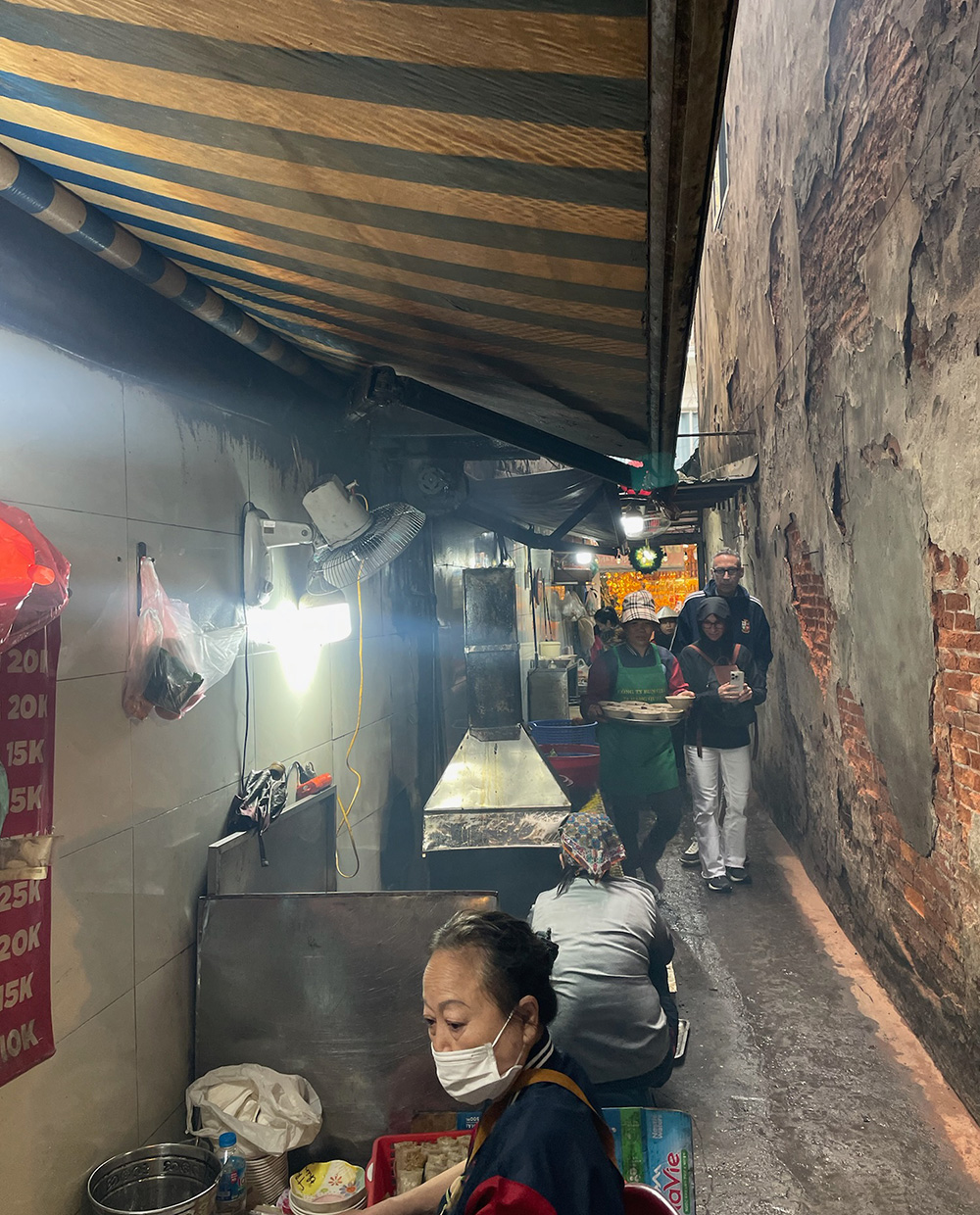

The second part of our tour started in the evening with bánh cuoốn. This consists of thin, soft rice sheets with various fillings such as pork or chicken, garnished with crispy fried shallots, served with a flavourful dipping sauce. We had ours at Bánh Cuoốn Gia Truyeền Thanh Vân, one of Hanoi’s most famous and long-standing bánh cuoốn restaurants. We then had our favourite dish of the tour: the famous phở bò. This fragrant beef noodle soup is a clear broth seasoned with spices. We tastes this at a small eaterie hidden down and alley and up a stairway
Drink
THE HAFLINGTON
The Haflington is hidden down a narrow alleyway and up several flights of steps and is a great example of Vietnam’s burgeoning cocktail culture. It is the first Vietnamese bar to break into Asia’s 50 Best Bars, securing 47th spot. The bar draws inspiration from grand European museums, featuring vintage décor and a striking dinosaur skeleton suspended above the bar. Its cocktail program offers refined classics and a seasonal menu that transforms historical voyages into innovative drinks.
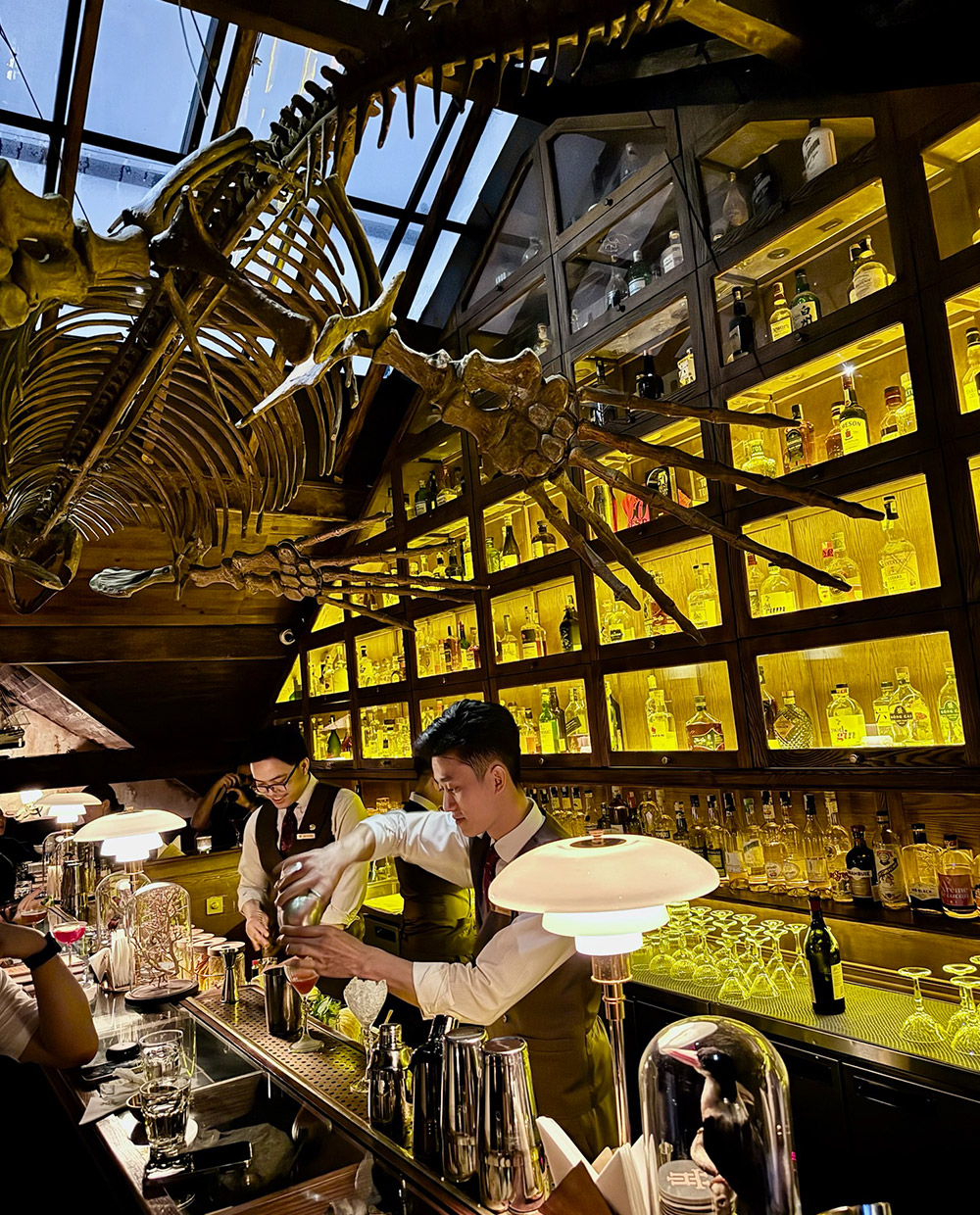
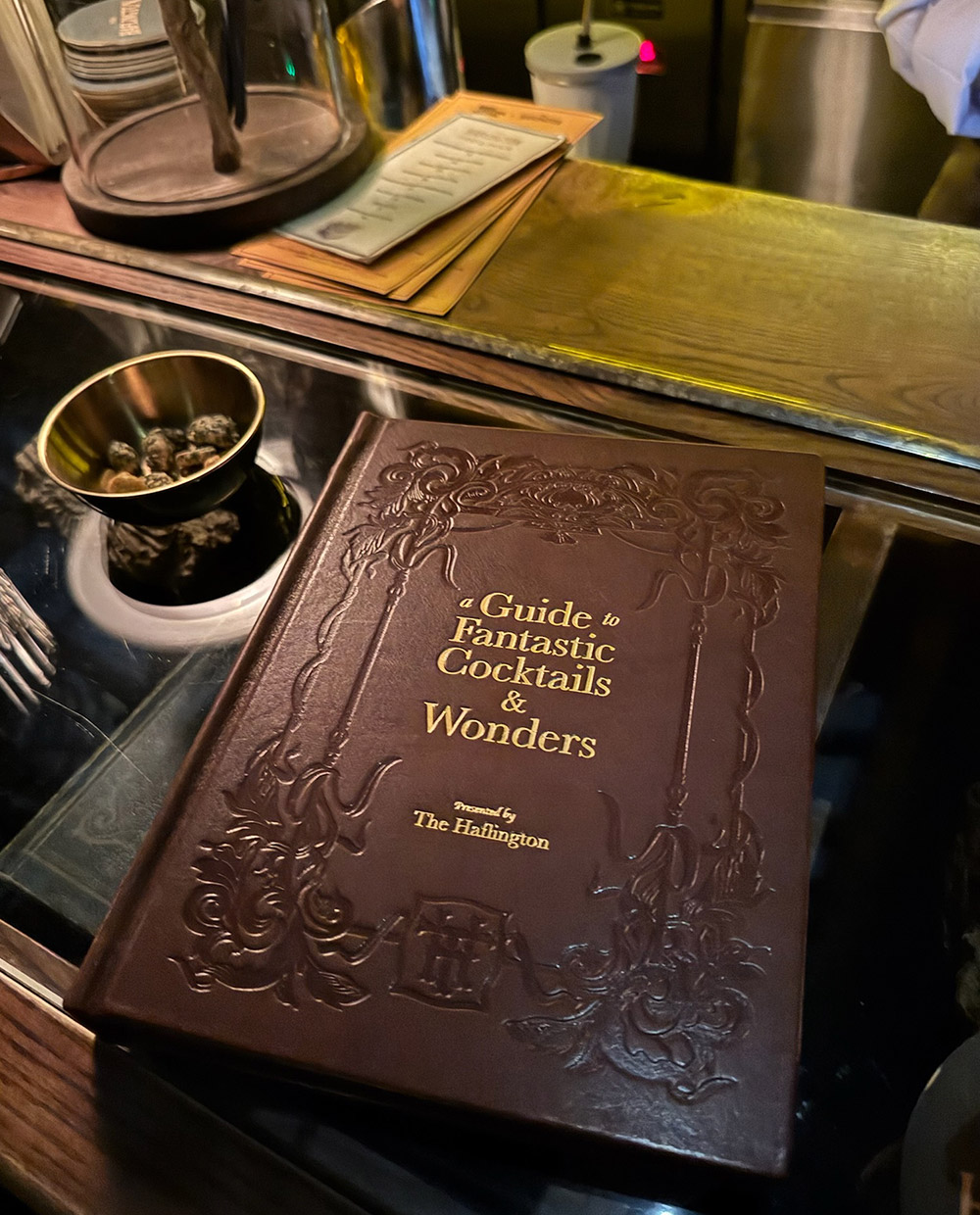

THE HUDSON ROOMS (CAPELLA)
The Hudson Rooms is one of Hanoi’s numerous rooftop bars. The decor blends 1920s New York speakeasy charm with Hanoi’s timeless elegance, featuring rich leather banquettes and brass detailing. The cocktail menu is a love letter to classic mixology, featuring expertly crafted drinks with a modern twist.
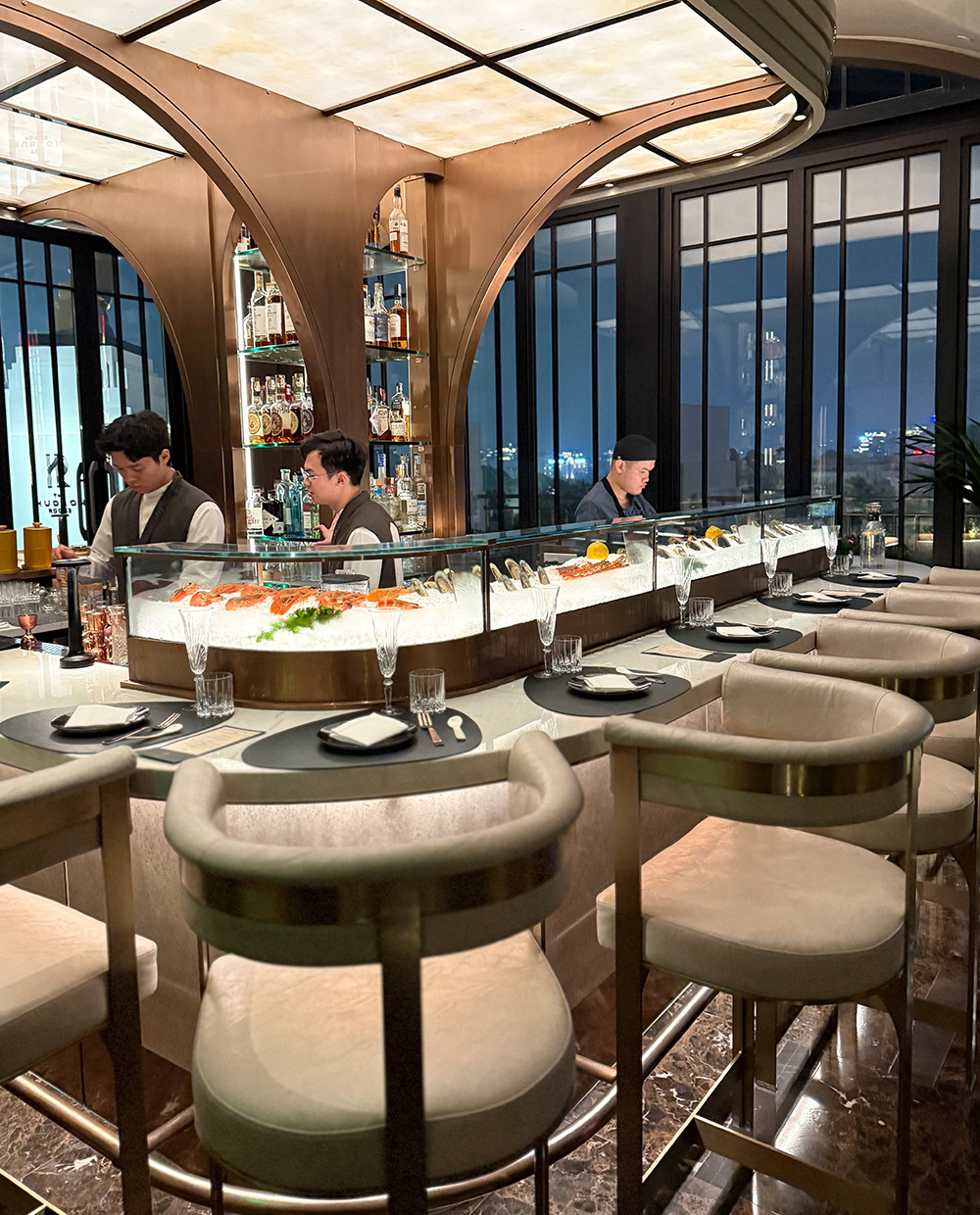

BEER HOUSES
Bia Hoi is a local beer is brewed fresh each morning and delivered by motorbike to the city’s countless beer houses. It’s light, crisp, and ridiculously cheap! Ta Hien corner is a well-known centre for this experience, though a bit touristy. Ask your guide to take you to a more authentic local place, such as Bia Phượng that we stopped off at. Pull up a plastic stool, order a glass of Bia Hoi and embrace the communal atmosphere!

Coffee & brunch
Hanoi’s coffee culture is deeply rooted in history and tradition, with a unique blend of French colonial influence and Vietnamese creativity. Street-side cafés, small hidden coffee shops and modern specialty cafés are all part of the city’s vibrant coffee scene.
Hanoi’s most famous coffee specialty is egg coffee, a rich and creamy drink made by whisking egg yolks with sugar and condensed milk, then layering it over strong Vietnamese coffee. It tastes better that it sounds! The drink was invented in the 1940s by a bartender at the Sofitel Legend Metropole Hotel, during a time when milk was scarce, whisking egg yolks as a substitute.
There are countless coffee shops in Hanoi, but here are three we enjoyed.
Hanoi Coffee Culture blends contemporary design with cozy charm, featuring exposed brick walls and lush greenery. A good place to take a break when wandering through the Old Quarter.
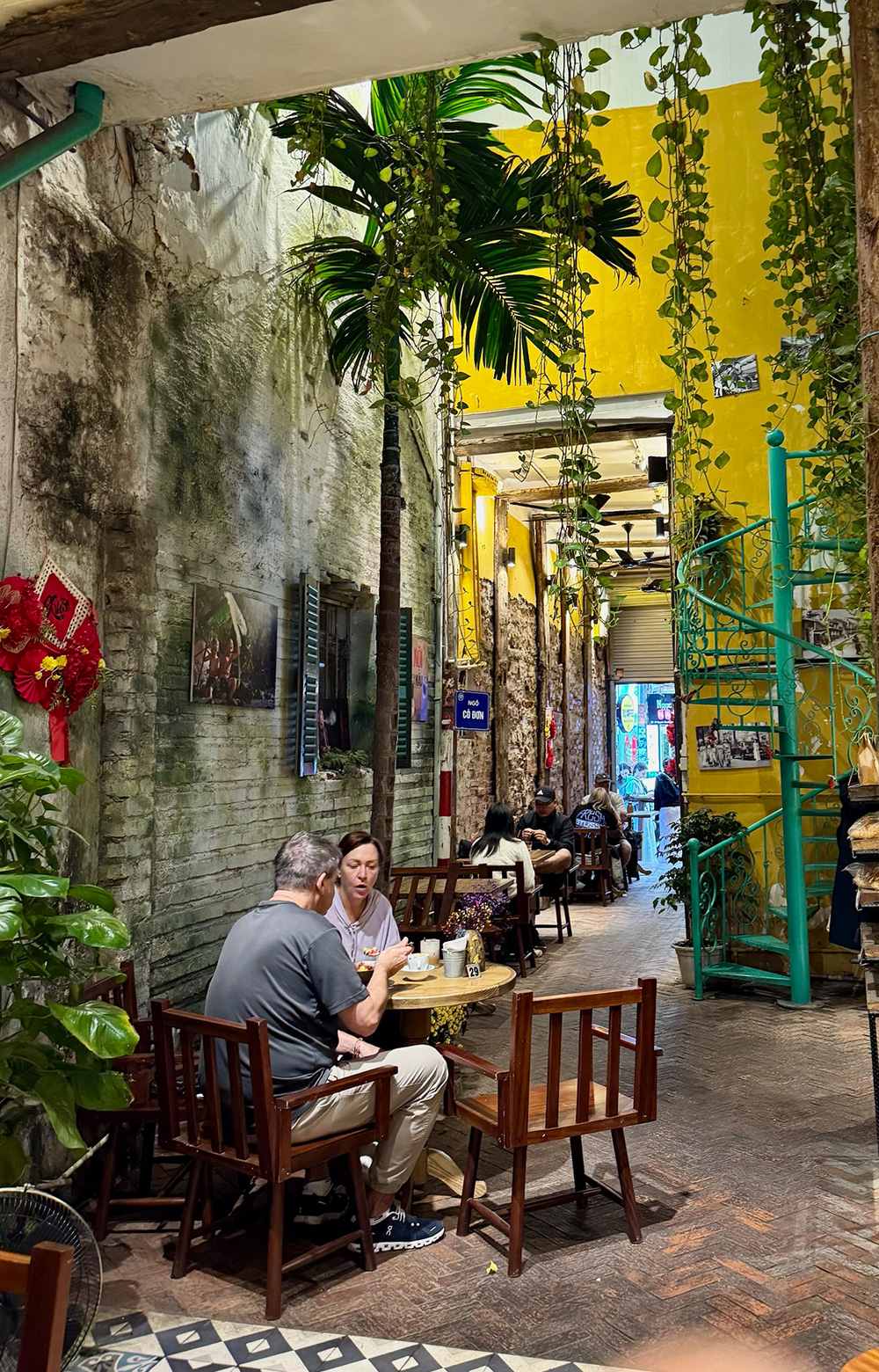
Giao Mùa Coffee is a contemporary coffee shop with a unique design. Each of the five floors features rustic, cream-coloured curved walls with a cave-like design. Inside, wooden furnishings enhance the warm and inviting ambiance. A selection of coffee beverages are served, including traditional black coffee with condensed milk and iced coffees too.


Café Aguri is a contemporary, cosy coffee shop. A good spot to relax after exploring nearby Temple of Literature.

THE HANOI SOCIAL CLUB
The Hanoi Social Club was on our list of places to try, but we ran out of time! Housed in a 1920s French colonial villa in the Old Quarter, it is supposed to be a popular brunch spot for the cool kids of Hanoi. Let us know what it’s like if you manage to visit!
Halong Bay
A two hour drive east took us to the second part of our trip: an overnight cruise in UNESCO World Heritage site Halong Bay. We sailed on Heritage Line’s Ginger, which blended old-world charm and modern luxury. It featured warm wood interiors and only 12 spacious suites, each with a private balcony.


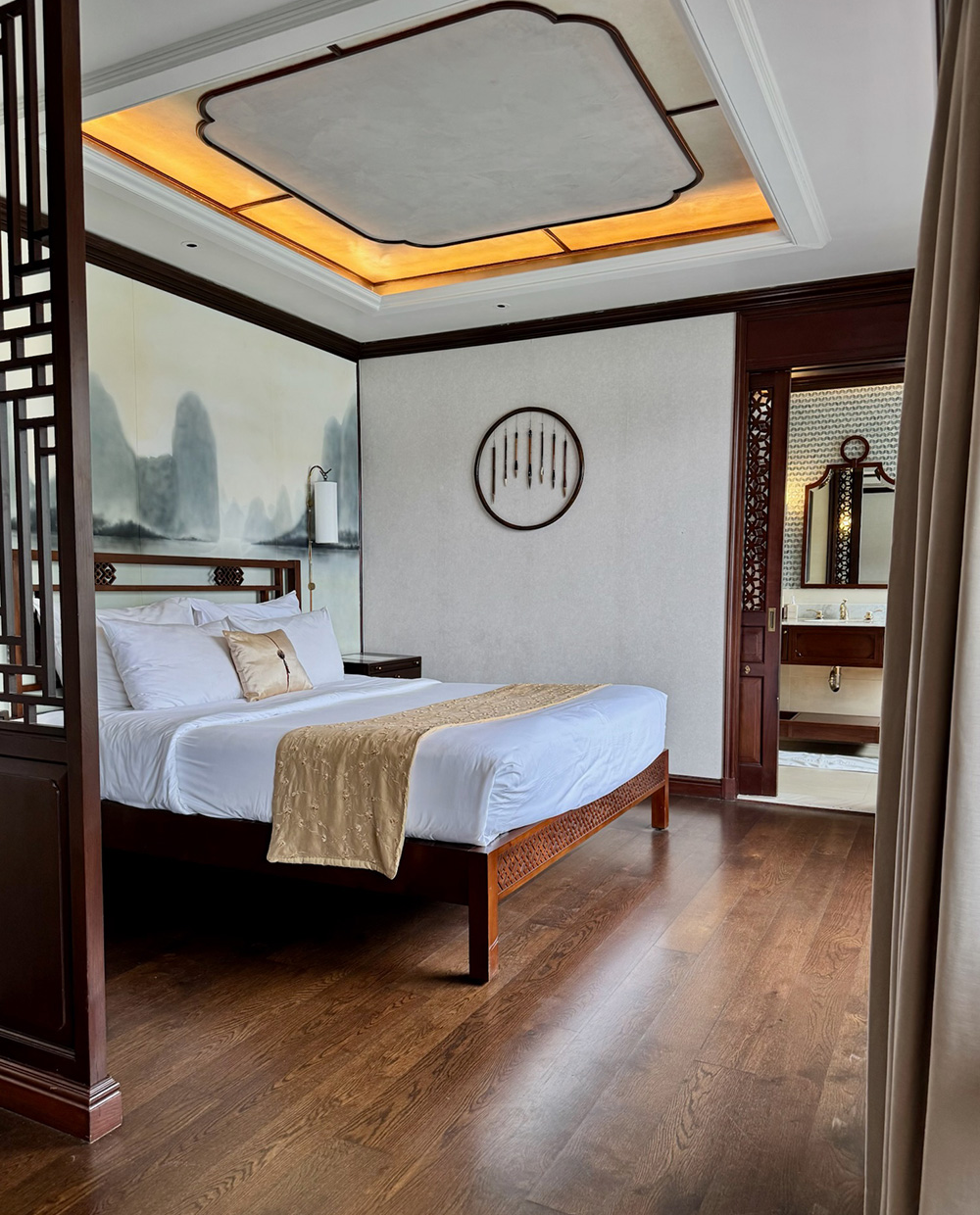
We gently cruised through jade-green waters, with views of towering limestone “karsts”. Lunch, dinner and breakfast were all served in the dining room deck.



A nice feature of our cruise was exploring Lan Ha Bay, a quieter, more untouched part of the area. We also stopped off at Cat Ba Island for a cycling tour through forests and past lakes.
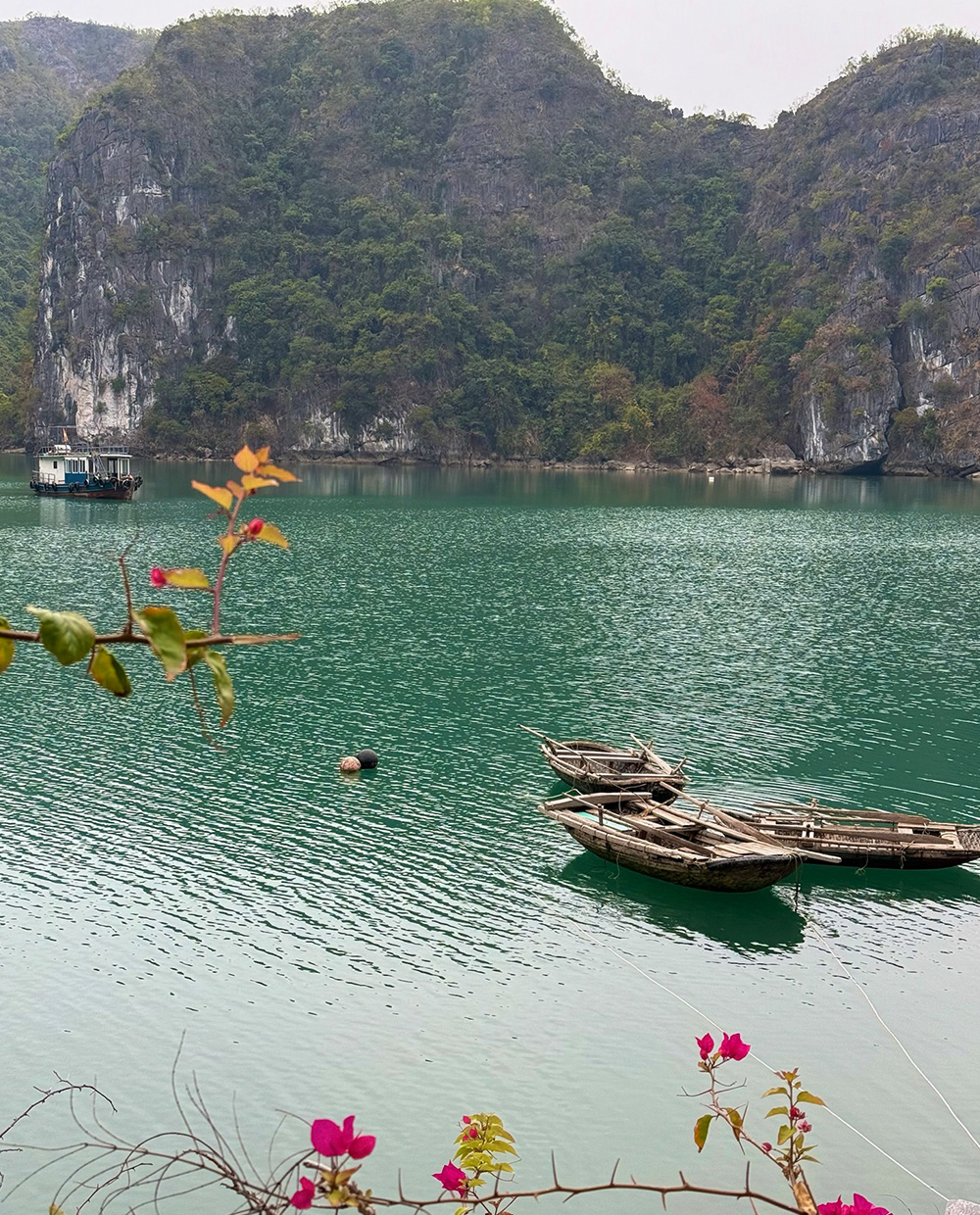
Hoi An
A short flight south took us to Hoi An, on the Thu Bon River in Central Vietnam. Once a thriving trading port, the town absorbed the influences of Japanese and Chinese merchants who settled here centuries ago. Under French rule, it became an administrative centre, adding another layer to its architectural story with colonial grandeur, now faded. Today, the town is a UNESCO World Heritage site, home to over 800 preserved building, from grand Chinese assembly halls to elegant French colonial residences and centuries-old merchant houses. It is also a lively, colourful town full of cafés, bars and restaurants.


The combination of history, entertainment and nearby beaches means it has become very popular and does have a bit of a touristy feel to it. Our favourite experiences were when we escaped the crowds, first on a bike ride across the paddy fields to visit some smaller villages and then a couple of memorable dinners (see below).
Stay
FOUR SEASONS
The Four Seasons Hoi An is set along a stretch of private beach, offering a secluded sanctuary worlds away from the bustling streets of Hoi An’s old town. The location is ideal: far enough for peace and quiet, yet just a short drive from the city’s lantern-lit streets.
The resort itself is stunning: elegant, expansive and high-end. The pools are spectacular, with the main pool stretching endlessly toward the private beach and ocean. This is an all-villa resort: every guest has their own private sanctuary with a beautiful interior design, elegant furnishings and sea views. Villas range from the huge one-bedroom one we had to ginormous multi-bedroom residences with private pools and outdoor living areas! We stayed in one of the beachfront villas (below right), with the luxury of direct access to the beach and a wake-up call of waves crashing on the shore.


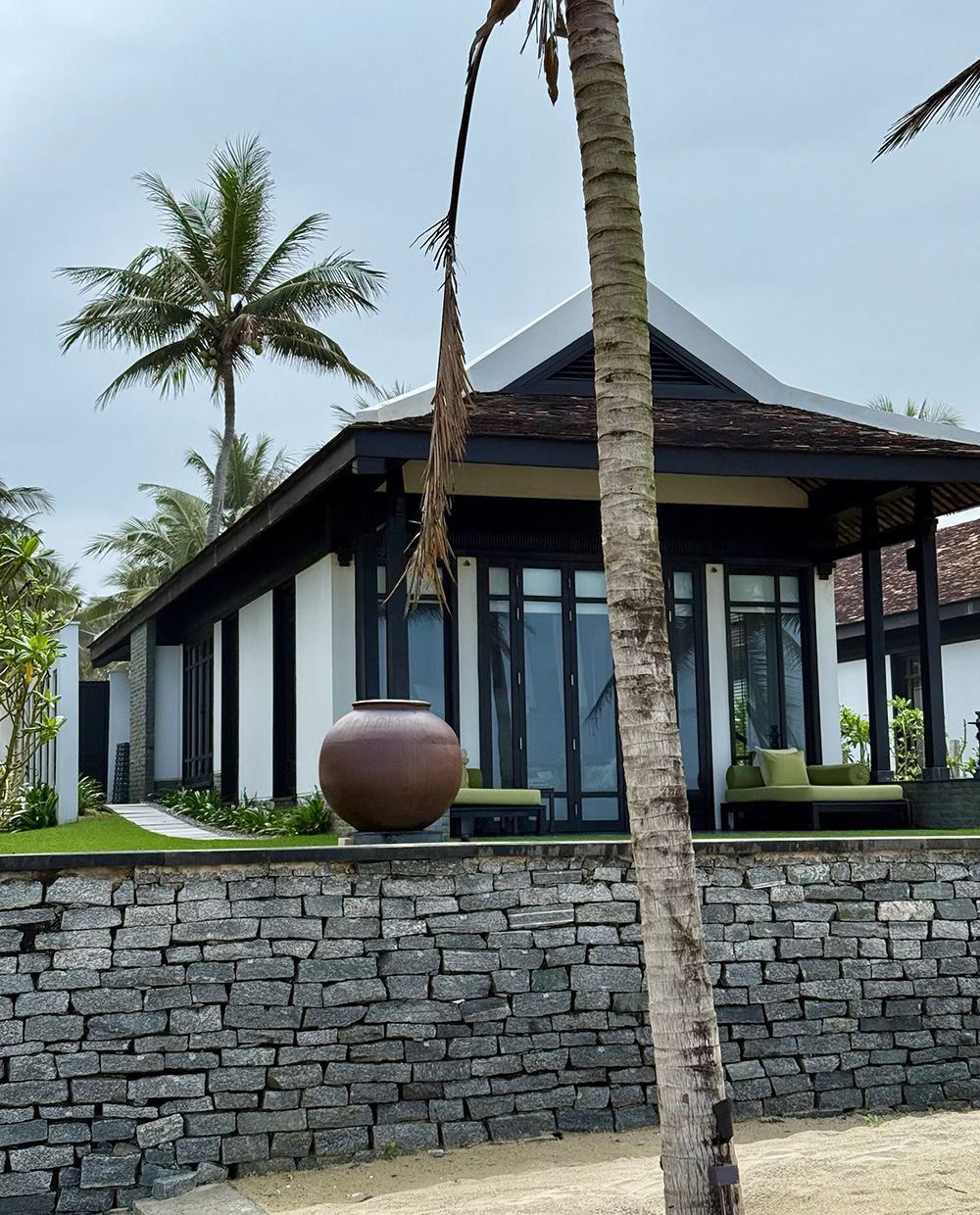
We had a lovely dinner on site at Lá Sen, which serves up Vietnamese dishes with a touch of French elegance. We had lunch and drinks at the more relaxed Beach Bar (below). There were a couple of other dining options we didn’t try. NAYUU offers an intimate but pricey Japanese omakase experience. Café Nam Hai offers opulent Indian dinners that we didn’t fancy on an Asian trip.
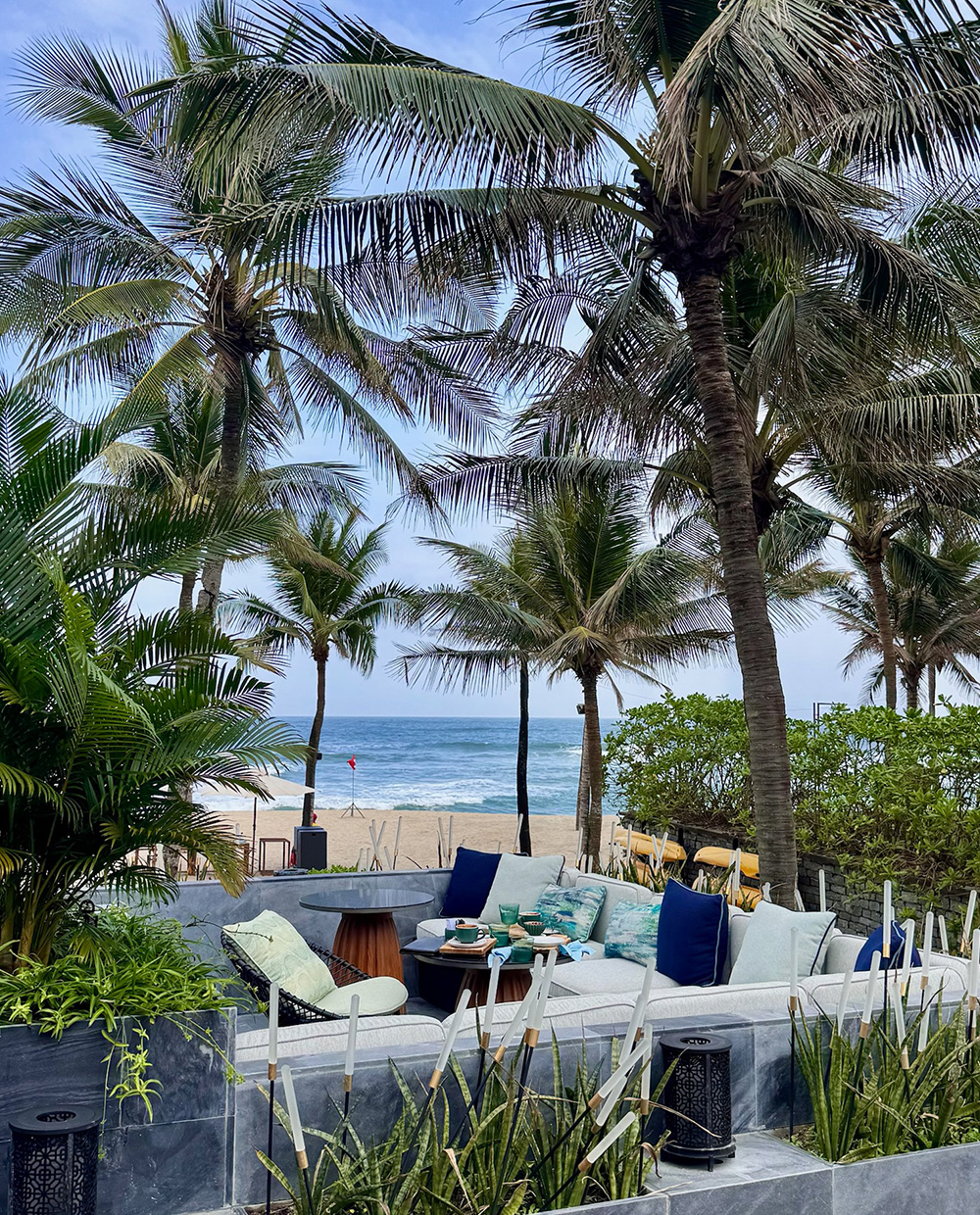
For full-on relaxation, the serene, beautifully designed spa offers traditional Vietnamese massages or a more modern wellness rituals in individual spa pavilions on a lake. We also enjoyed the resort’s impressive sports facilities, including tennis, padel tennis and pickleball.
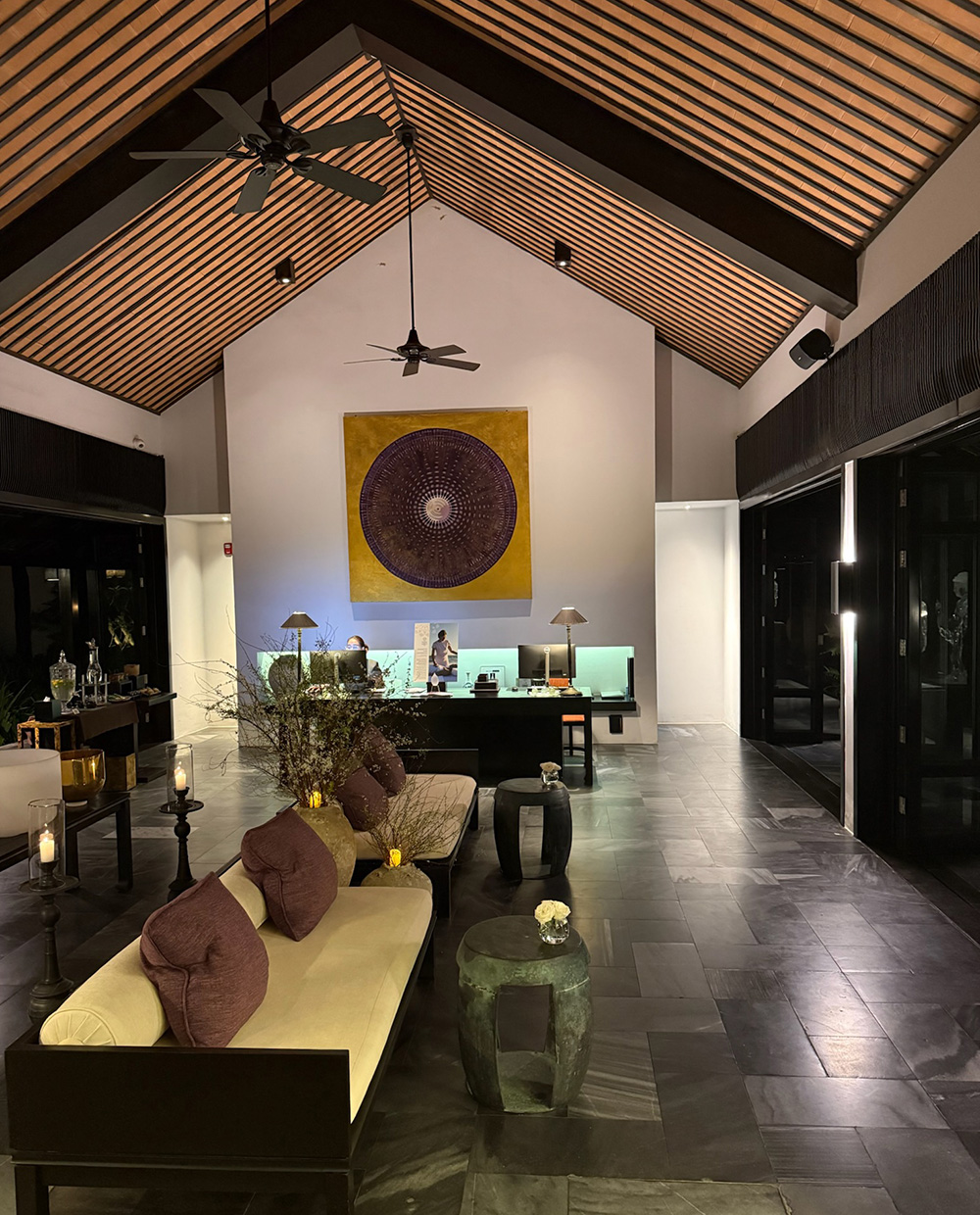

Do
OLD TOWN
The Old Town ticket (120,000 VND) allows you to explore five historic sites, each offering a deeper look into Hoi An’s rich cultural tapestry. Some of the top sights to see include the following:
Fujian Chinese Assembly Hall
Built in 1697, the Fujian Chinese Assembly Hall is a dazzling display of Chinese heritage. It originally served as a gathering place for Fujianese merchants before evolving into a temple dedicated to Thien Hau, the goddess of the sea. The entrance has lacquered columns and guardian statues standing watch. Inside, giant pink incense coils hang from the ceiling, each carrying written prayers and wishes from worshippers. Fierce-looking deities are said to assist Thien Hau, sitting alongside a replica of an ancient Chinese boat. A set of midwife statues are believed to bestow newborns with their first skill in life.
Cantonese Chinese Assembly Hall
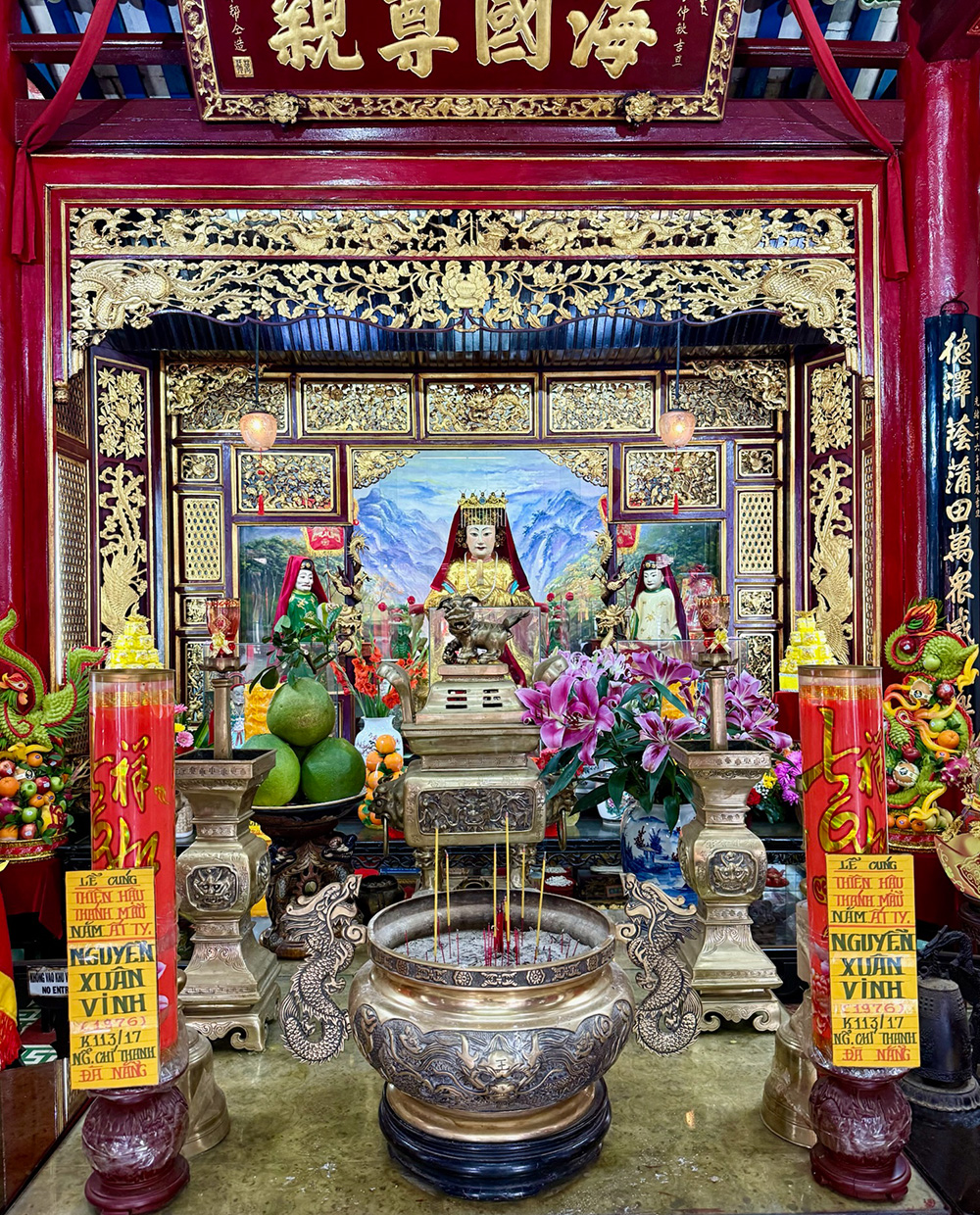

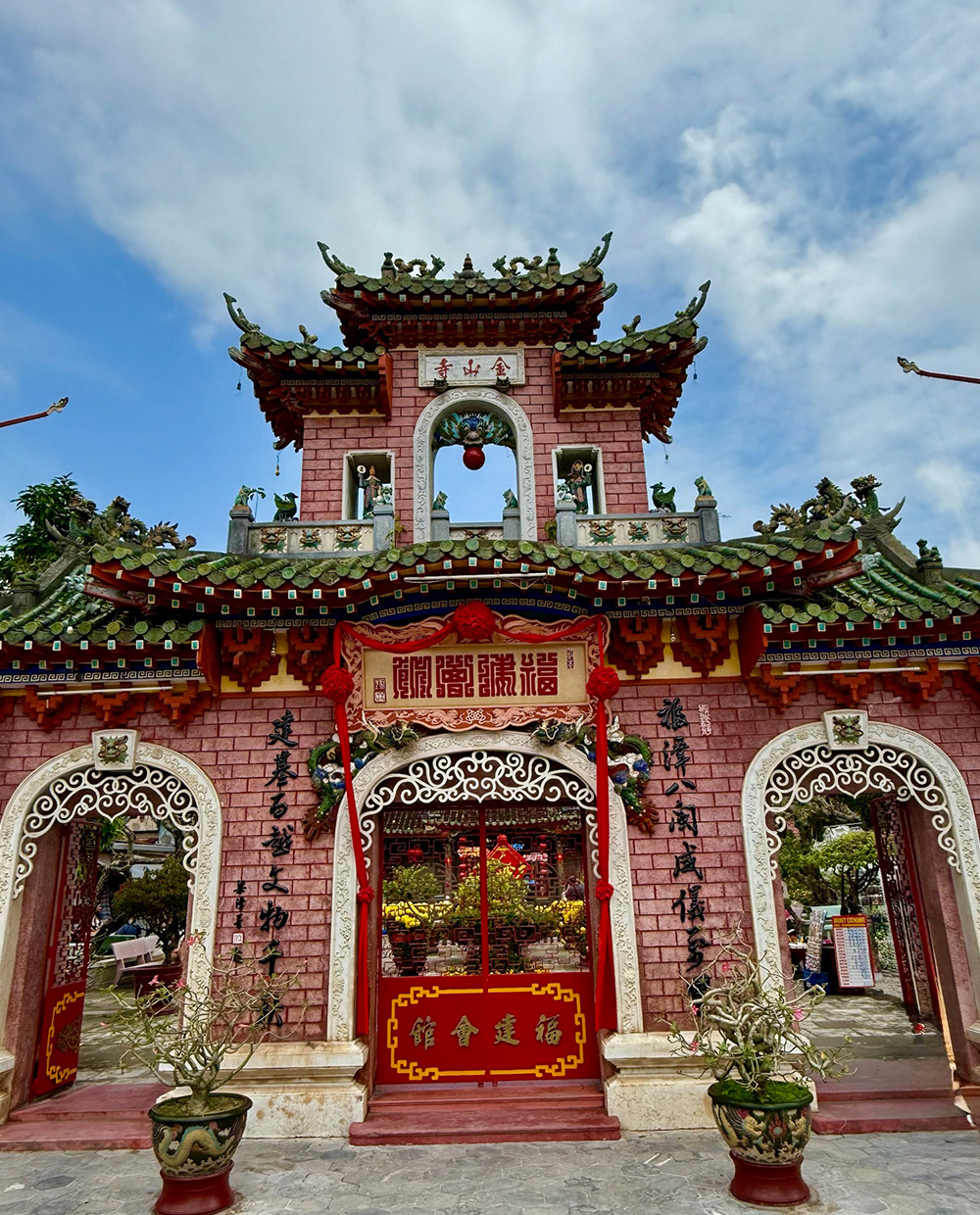
The Cantonese Chinese Assembly Hall is a lesser known monument also showcases the rich cultural heritage of the city’s Chinese community. Built in the late 19th century by Cantonese merchants, it blends traditional Chinese architecture with intricate carvings, vibrant ceramic mosaics and elaborate dragon sculptures. The hall, originally a gathering place for Chinese immigrants, is now a peaceful sanctuary dedicated to the veneration of Guan Yu, the revered general from the Three Kingdoms period.
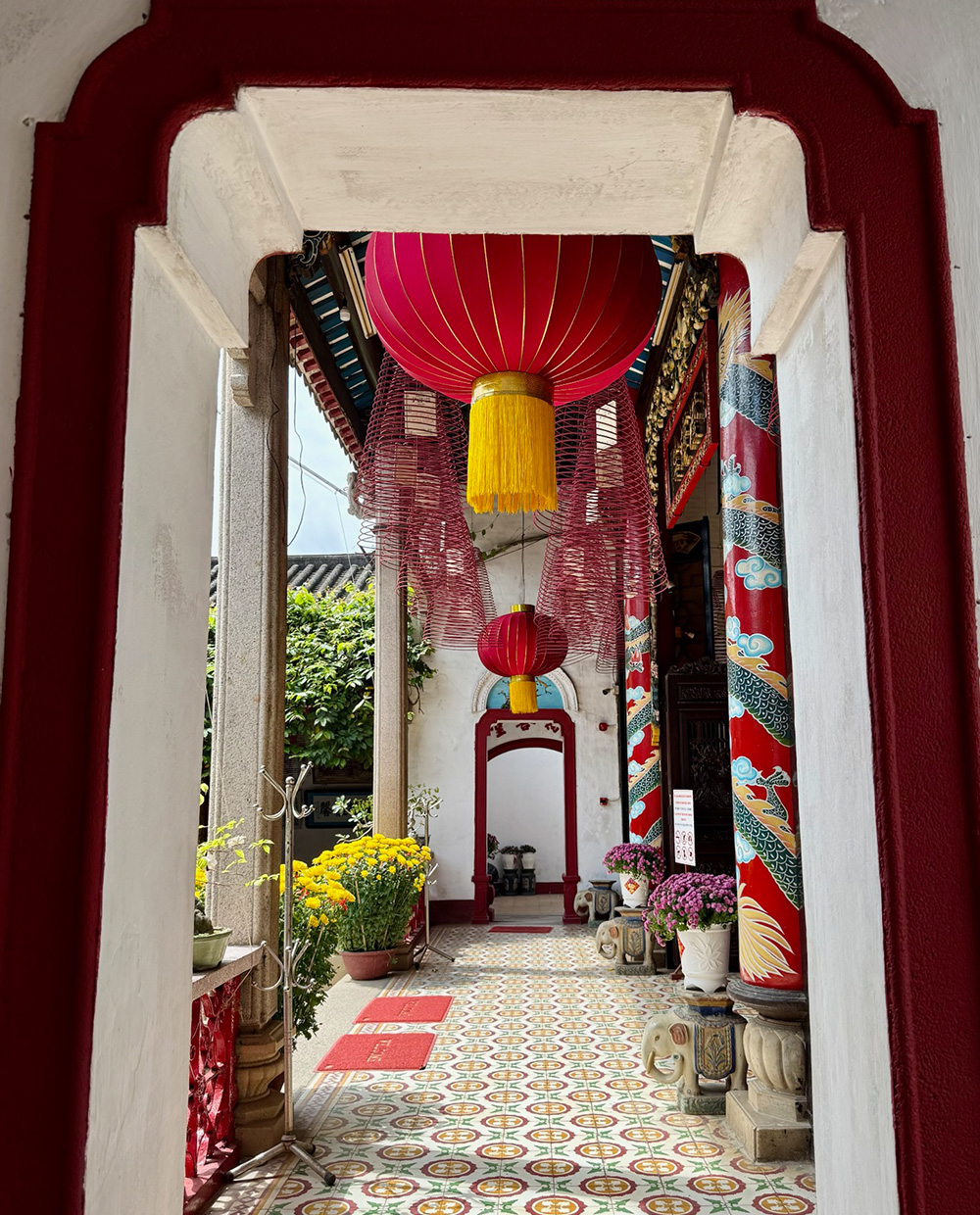
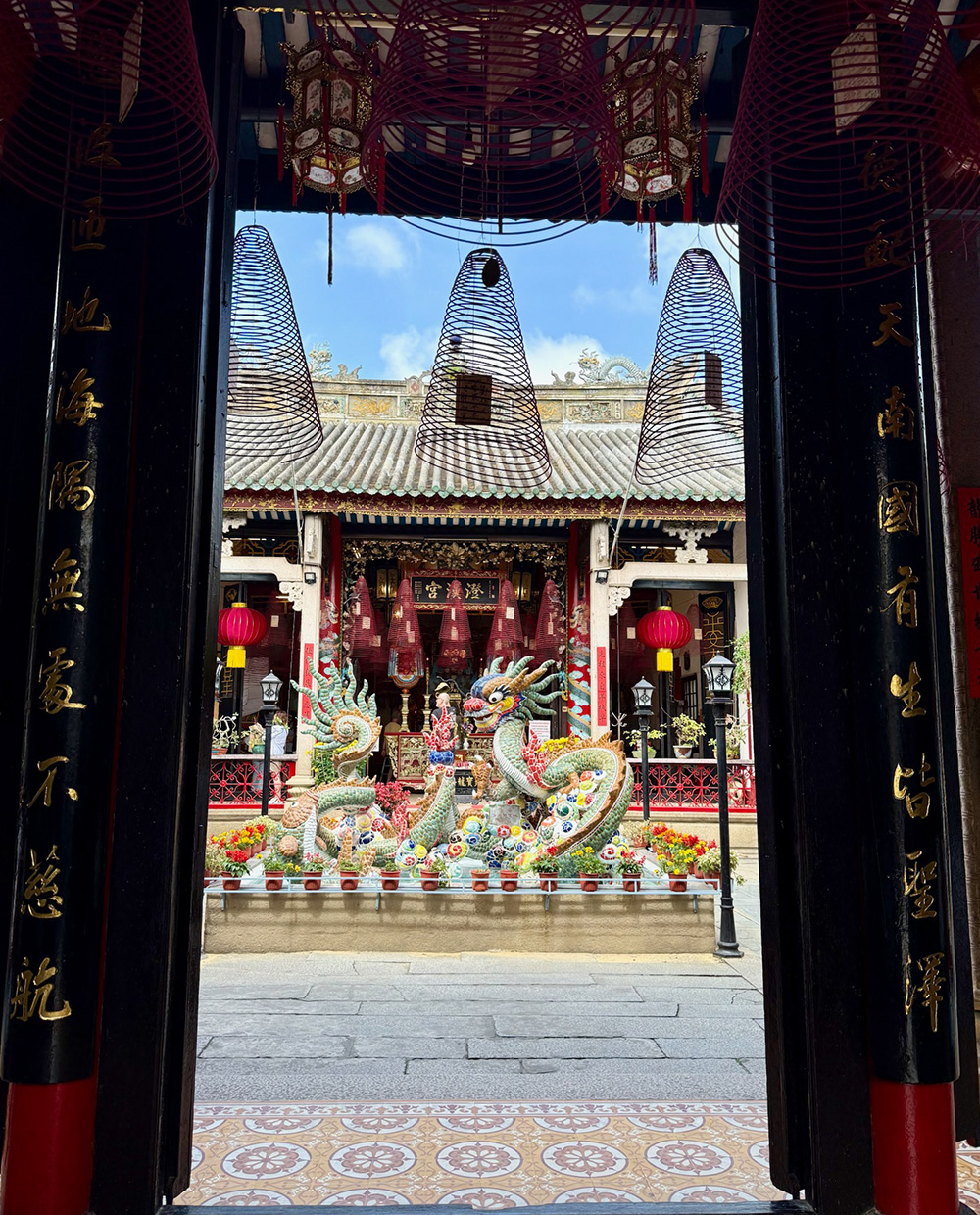
Tan Ky House
Tan Ky House is a 200-year-old merchant’s residence that captures the essence of Vietnamese, Japanese and Chinese architectural fusion. Unlike many historic sites, this one is still privately owned, offering an intimate, lived-in feel. The visit takes in ornate wooden beams carved with crossed sabers, open-to-sky courtyards and delicate Chinese poems inlaid in mother-of-pearl.
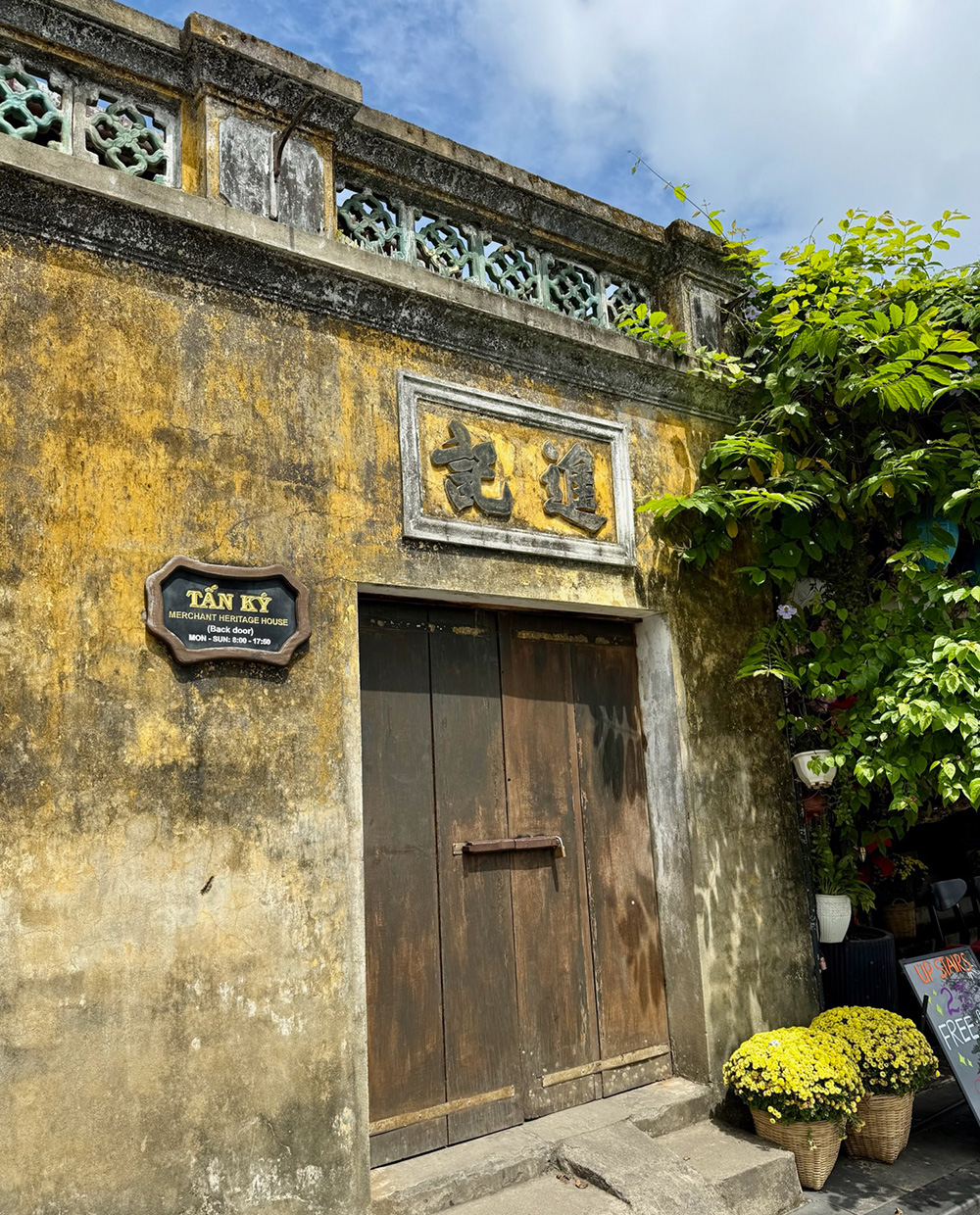

Japanese Covered Bridge
Perhaps the most iconic landmark in Hoi An, the Japanese Covered Bridge, painted in soft pink with a curved pagoda-style roof, is both a historic crossing and a cultural symbol. Built by the Japanese community in the 17th century, the bridge was designed to link them to the Chinese quarter across the river. Local legend says construction began in the Year of the Dog and finished in the Year of the Monkey, explaining why stone statues of these animals stand guard at each end.

TAILORS SHOPS
Hoi An is famous for its 200 tailor shops, turning out everything from custom suits to silk dresses, often in under 24 hours. These skilled tailors offer high-quality work at great prices. Just pick a style, choose your fabric and let the artisans handle the rest. We had two suits made at Tina Design, recommended by our guide. And the two Taylor girls were very happy with the work of the tailor!
COOKING CLASS & CENTRAL MARKET
A cooking class at Vy’s Market is an immersive and fun dive into the flavours, techniques and traditions of Vietnamese cuisine. The class began with a guided tour of the town’s vibrant central market, where you discover the essential herbs, spices and fresh produce that define the country’s dishes.
Back at the state-of-the-art cooking station, you learn to craft signature Vietnamese staples like bánh xèo (crispy pancakes) and fresh spring rolls. The interactive experience includes tastings, hands-on preparation and the chance to savour your own creations! One tip is to have a light breakfast as there is a lot of food to eat!
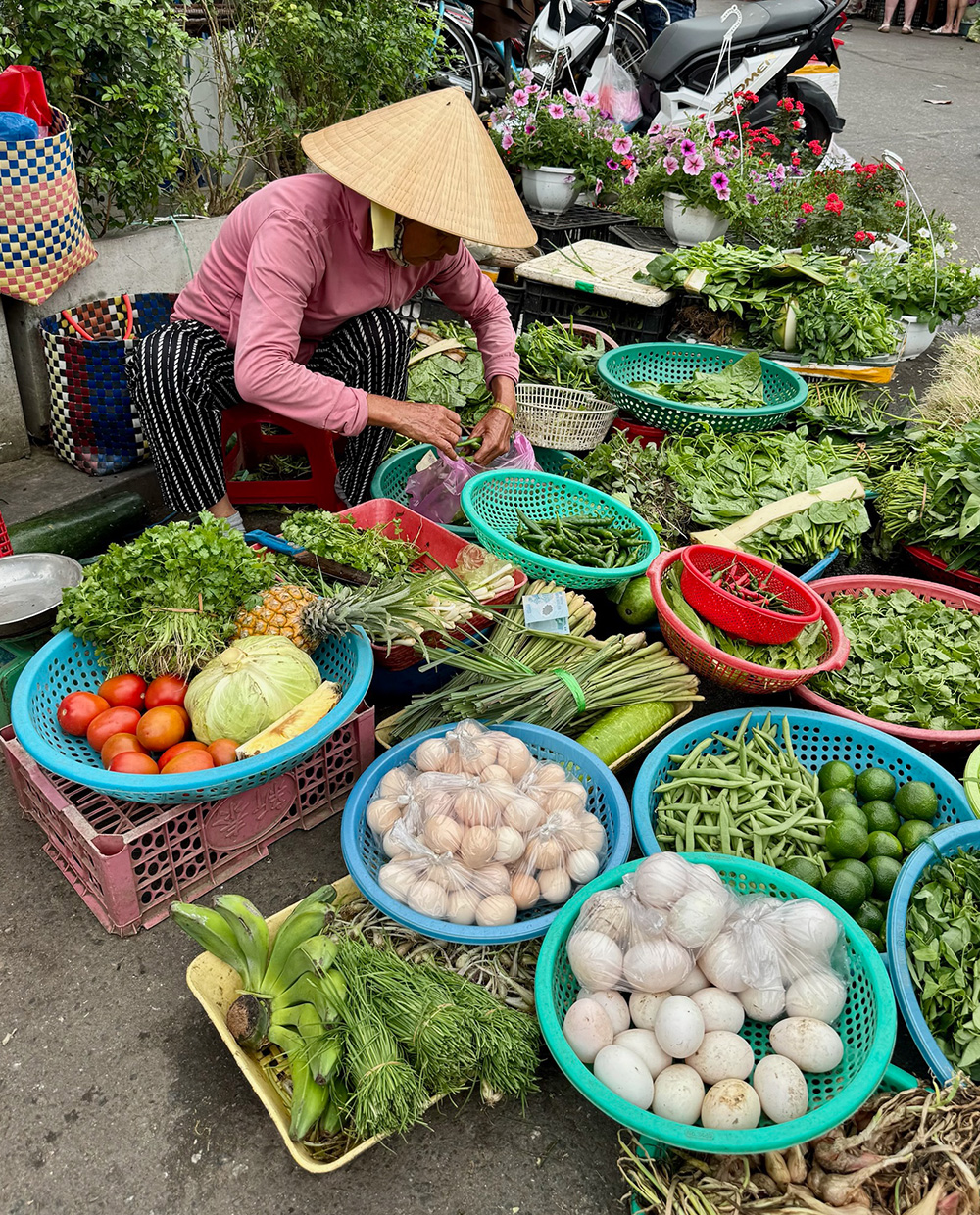
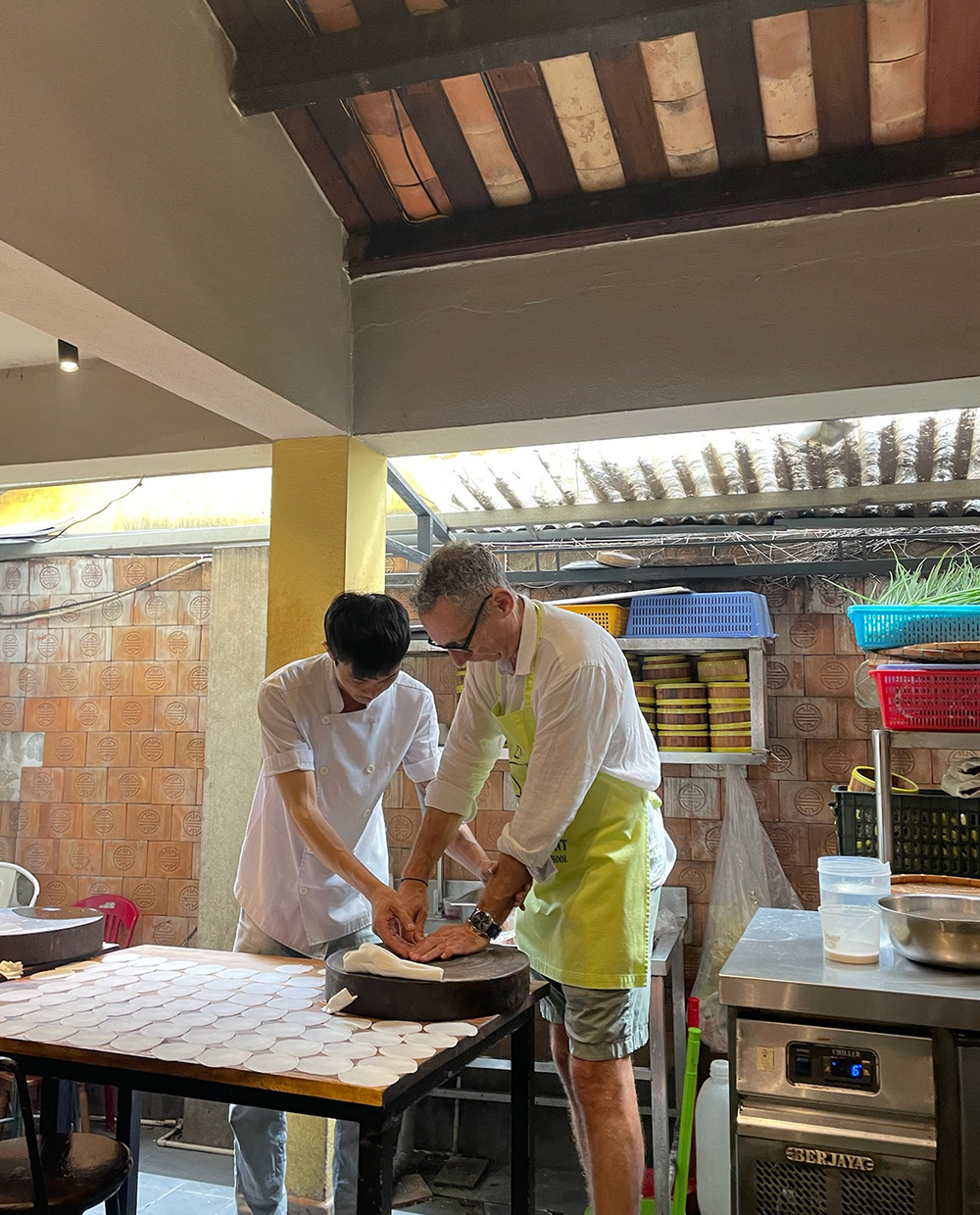

BIKE TOUR
We spent a morning leisurely cycling through the scenic countryside of Vietnam, far from the traffic and the noises of the town. We crossed the Song Thu river delta to the island of Cẩm Kim and then cycled through paddy fields and local villages. We visited local and family temples and saw how traditional basket boats are made. It felt more authentic and off-the-beaten track compared to the centre of Hoi An.


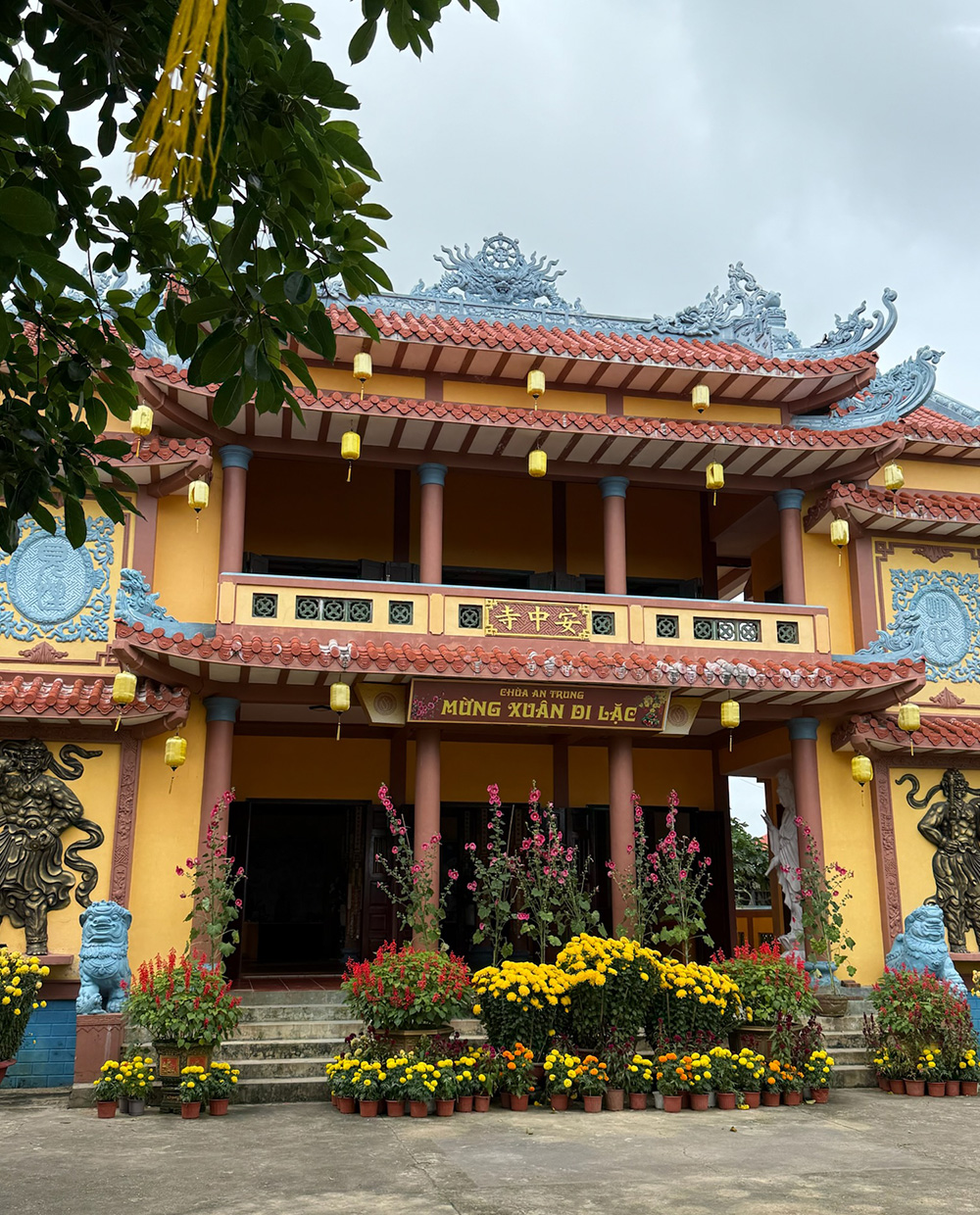
LANTERN BOAT RIDE
When night falls, lanterns light up the town. What seems like hundreds of boats line up ready to take you for a ride along the river. As part of your trip, you can light a paper lantern and cast it into the river as you make a wish. A bit like taking a gondola ride in Venice, it’s touristy but fun all the same only costs a few dollars!

MY SON
If you have extra time and are up for an inland adventure, consider a trip to My Son Sanctuary. Once home to over 70 Hindu temples, the site was heavily bombed during the war, leaving around 20 in various states of ruin. Some have been painstakingly restored, with Group A being the most impressive. It’s about an hour’s drive from Hoi An and arriving early helps beat the crowds. We skipped as we ran out of town and have seen the temples of Angkor Wat in Cambodia.
Dine
TOK
Tok is set in the heart of the rice paddies, hidden from the hustle and bustle of Hoi An’s old town. We loved the modern fusion cuisine here. High quality, local ingredients and produce from the on-site organic vegetable garden used to create fresh, seasonal dishes. This was our favouring dinner spot of the whole trip.


MUA
Mùa, the Vietnamese word for “seasons,” captures the philosophy behind this modern fine dining spot in Hoi An, where Vietnamese ingredients take centre stage. Chef Tru Lang, born in France and trained in some of the world’s top kitchens, found his way back to Vietnam. The menu shifts with the seasons while staying true to the essence of a home-cooked Vietnamese meal. Chose the 14 or 9 course tasting menu (for only c. £35 at the time of writing). Tucked away in the garden of Tra Que Mansion, the setting is a serene and secluded escape from the hustle and bustle of the Old Town.


MANGO ROOMS
Mango Rooms is a colourful restaurant with tables overlooking the river, serving decent modern Vietnamese and fusion cuisine. Not one of our favourite dinner spots, but a safe and affordable option.
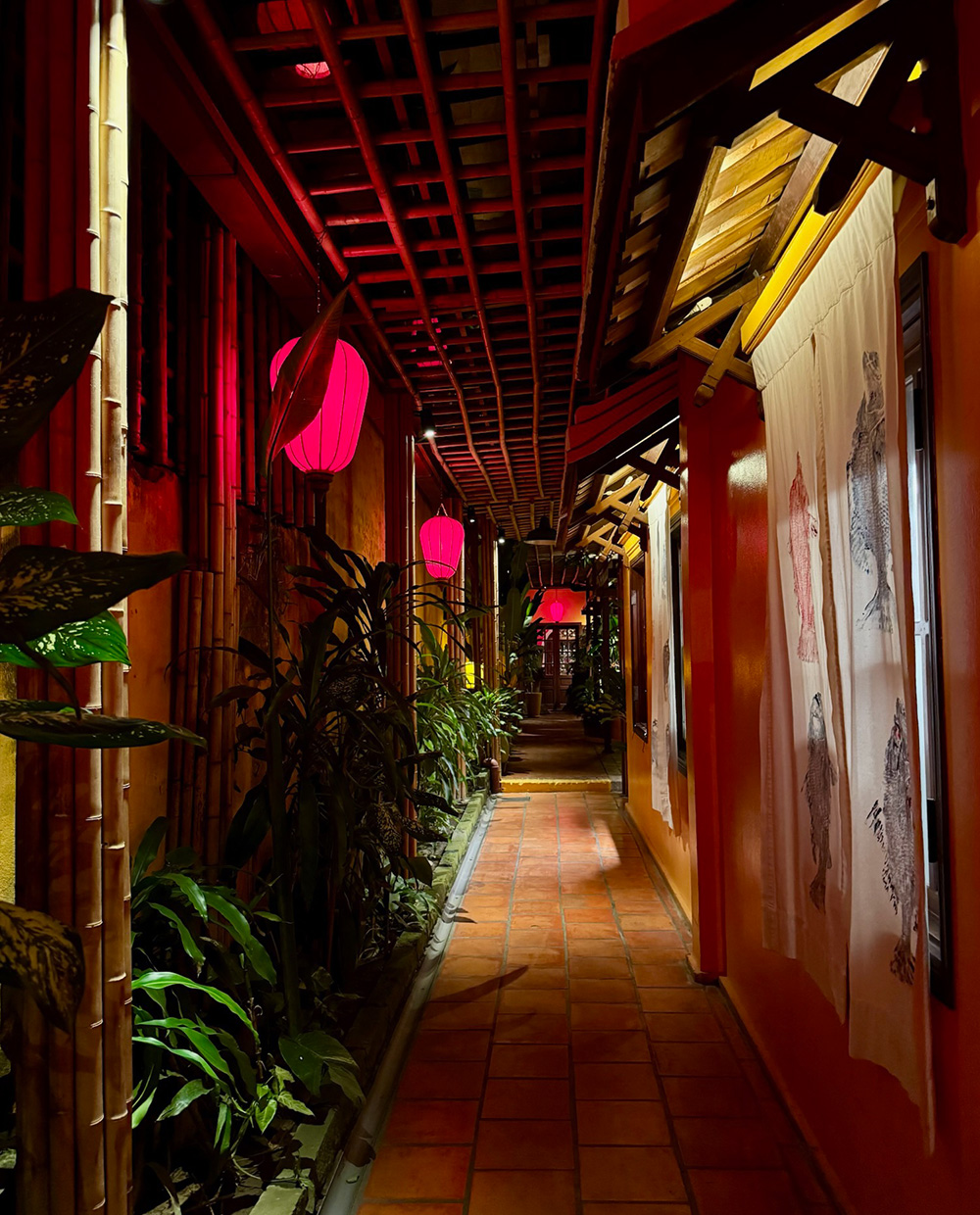

HY
We didn’t have time to eat at Hy Restaurant, but it’s highly rated for local cuisine and worth considering if you’re looking for an atmospheric dinner spot. Tucked behind the Japanese Bridge, it offers a charming setting with fairy lights, waterside tables, and a more relaxed vibe away from the crowds.
COM LINH
Com Linh is another well rated local restaurant where you cannot make reservations and need to queue. In the heart of Hoi An it looked very lively if a little too touristy for our liking!
MADAME KHAN
As mentioned earlier, Banh Mi is the Vietnamese sandwich made with a light, crispy baguette stuffed with meat, vegetables and condiments. This spot has become famous via social media and other press coverage and did a decent job when we visited. Mainly take-away with limited seating, so more for a lunch on the hoof.
Café
HAT A PHO HOI
Hạt A PhoốHội is a riverside café with a laid-back vibe and a perfect spot to escape Hoi An’s bustle over a coffee. The jazz soundtrack sets the mood, while the scenic views and vintage-inspired decor make it easy to linger.
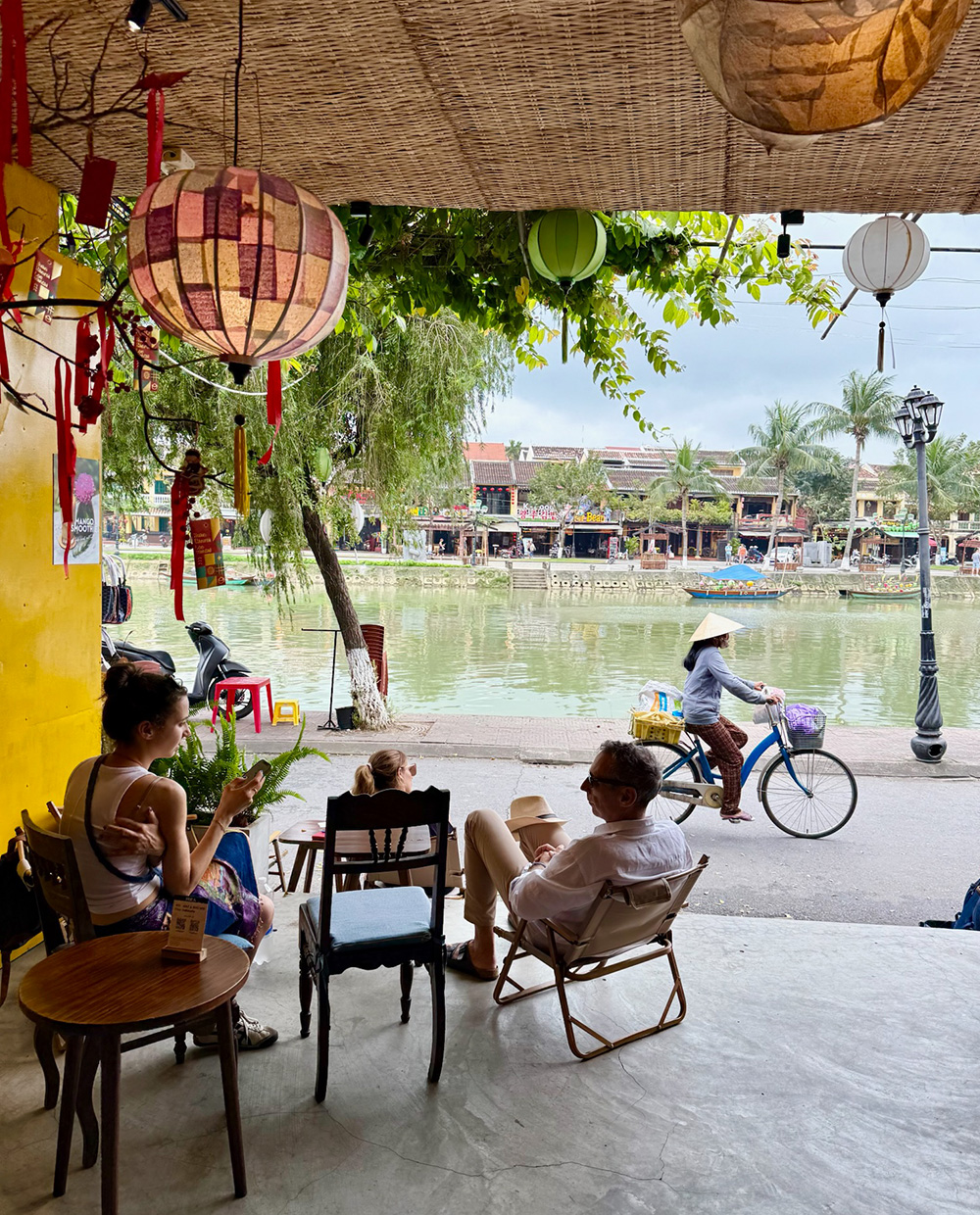

Drink
MEZCAL COCTELERIA
Mezcal Cocteleria is Vietnam’s first Agave Spirits Cocktail Bar. Expert bartenders shake up some of the best cocktails in town and the place has a low-lit, moody ambiance we loved. Whether you’re into classic margaritas or something more adventurous, drinks here are crafted with serious skill.



Saigon/Ho Chi Minh City
Ho Chi Minh City, still called Saigon by most locals, was our next stop, a short flight from Hoi An. It is a fast-paced, ever-evolving metropolis where sleek skyscrapers rise above a tangled web of buzzing motorbikes; it felt like a looser, more chaotic cousin of Singapore. As Vietnam’s commercial heart, the city hums with life, from trendy rooftop bars and stylish cafés to tucked-away vintage clothing shops and indie boutiques. But beneath its modern exterior, Saigon also a city bears the weight of history. Echoes of the Vietnam War linger, offering you a chance to see the conflict through a local lens.

Stay
HOTEL DES ARTS
Hotel Des Arts is a beautiful, bijou boutique property, Saigon. We loved the modern and elegant design, impeccable service and convenient location. The floor to ceiling windows in the spacious suites give you a great view of the city below.



Do
WAR REMNANTS MUSEUM
Step into the past at the War Remnants Museum, a must-visit to understand the Vietnam War from a local perspective. This powerful museum offers a gripping look at the realities of war, featuring military vehicles, weaponry, and haunting photographs that reveal the devastating impact of Agent Orange. A visit here is both eye-opening and deeply moving, providing a sobering perspective on Vietnam’s turbulent history.


WALK THE MAIN SIGHTS
After visiting the War Remnants Museum, we decided to explore some of Saigon’s most iconic landmarks on foot. This self-guided route took us past some of the city’s most famous colonial-era buildings and historical sites, allowing us to soak in the atmosphere without being rushed.
Our first stop was The Reunification Palace, a sprawling 1960s structure that once served as the presidential home of South Vietnam. From the outside, its brutalist architecture and sweeping balconies still exude a sense of power and history. The most striking feature is the wide front lawn, where military tanks from the 1975 Fall of Saigon still stand as silent reminders of the country’s past.
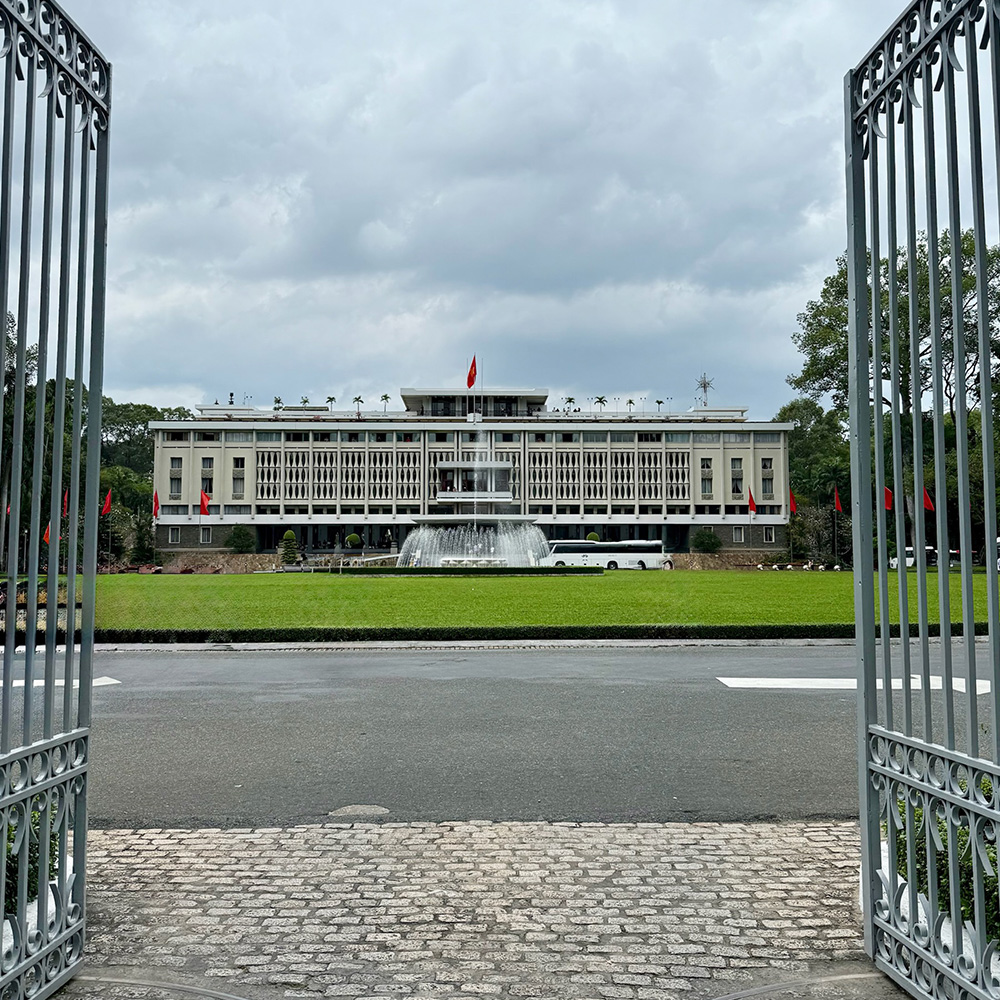
From there, we walked to Notre Dame Cathedral, an elegant red-brick basilica built by the French in the late 19th century and designed by Gustave Eiffel. Its twin bell towers rise high above the surrounding streets, making it one of the city’s most recognizable landmarks. Though currently under renovation, the facade remains a stunning example of colonial architecture.
Just across the street sits the Saigon Central Post Office, one of the most beautiful buildings in the city. Its bright yellow façade and grand arched windows make it feel like something straight out of 19th-century Paris. Stepping inside, we admired the vaulted ceilings, vintage telephone booths, and the huge map of old Saigon painted on the wall—one of the few places where we lingered a little longer to soak in the details.

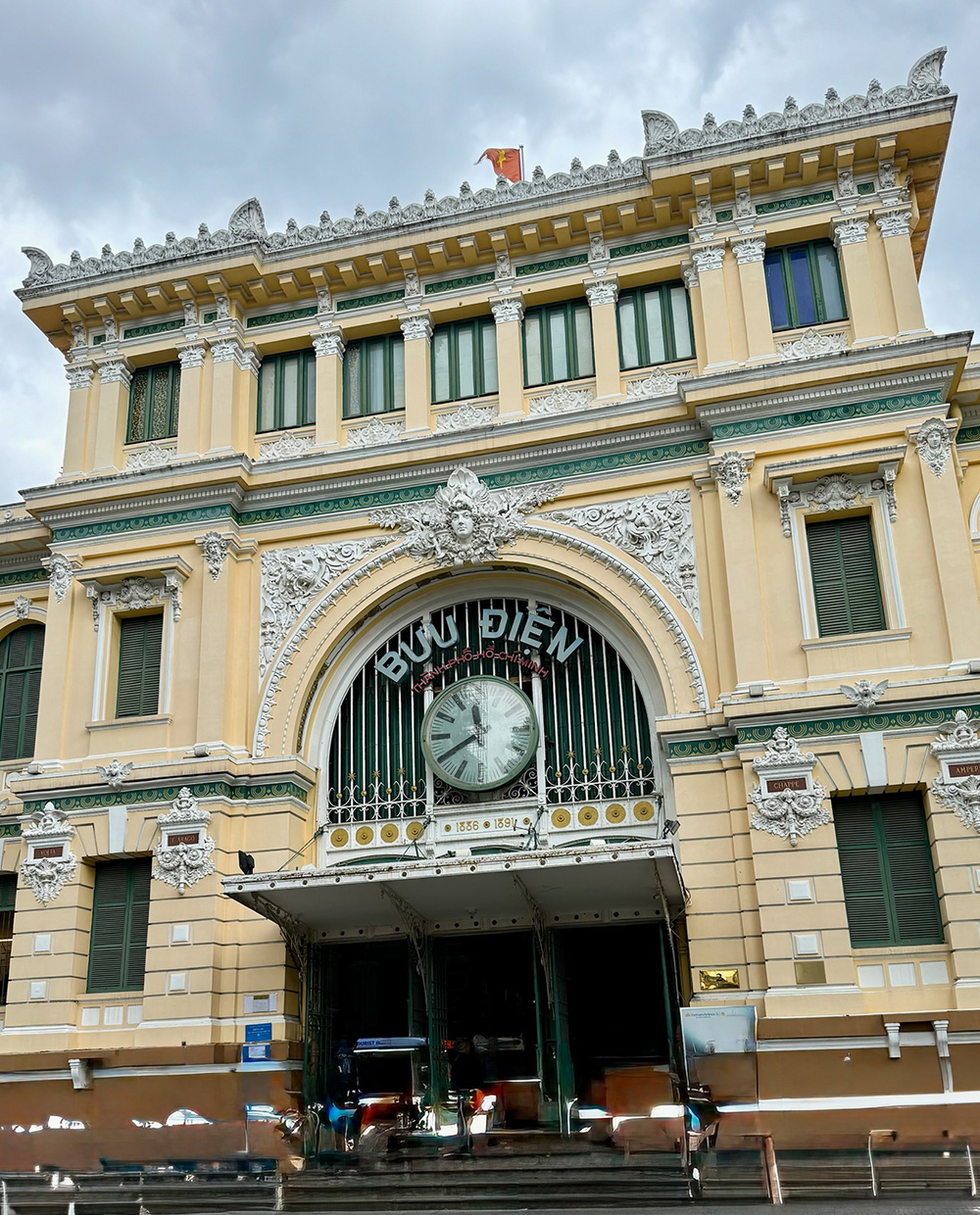

Continuing on, we reached Dong Khoi Street, a lively boulevard lined with boutiques, old colonial buildings, and luxury hotels. Once the heart of French Saigon, it still retains much of its charm, especially in the pastel-colored facades and wrought-iron balconies that give it an old-world elegance.
Finally, we arrived at the Saigon Opera House, an exquisite French colonial landmark that dominates the boulevard with its ornate white facade and intricate carvings. While we didn’t go inside, standing in front of its grand entrance was enough to appreciate its Belle Époque grandeur, a stark contrast to the modern glass towers that now surround it.
CU CHI TUNNELS
The Cu Chi Tunnels, located just outside Saigon, are one of Vietnam’s most popular historical sites, offering a fascinating glimpse into the country’s wartime past. However, given the three-hour round-trip to get there and with several of the Taylor family prone to claustrophobia we opted to spend our one full day in Saigon exploring the city instead!
This vast underground network was used by the Viet Cong during the Vietnam War, serving as hiding spots, supply routes and even makeshift hospitals. A tour of the tunnels takes you through camouflaged entrances, booby traps, and recreated wartime bunkers, providing a firsthand look at the ingenuity and resilience of the Vietnamese fighters. For the truly adventurous, there’s even the chance to climb down and crawl through a section of the tunnels.
GIAC LAM PAGODA
If you have time to soak up some culture, you could visit Giac Lam Pagoda, also known as the 10,000 Buddhas Pagoda. Built in 1744, it is Saigon’s oldest Buddhist pagoda, steeped in history and spiritual significance. The temple grounds are surprisingly lush and expansive, a rare pocket of greenery in the urban sprawl. Inside, thousands of Buddha images line the halls.
Cafés
OKKIO CAFÉ
OKKIO Café is a beautifully designed coffee spot in the heart of Ho Chi Minh City, offering a stylish escape with a perfect view of the Saigon Opera House. Known for its expertly brewed specialty coffee, OKKIO attracts a crowd of local hip kids, creatives and coffee lovers.
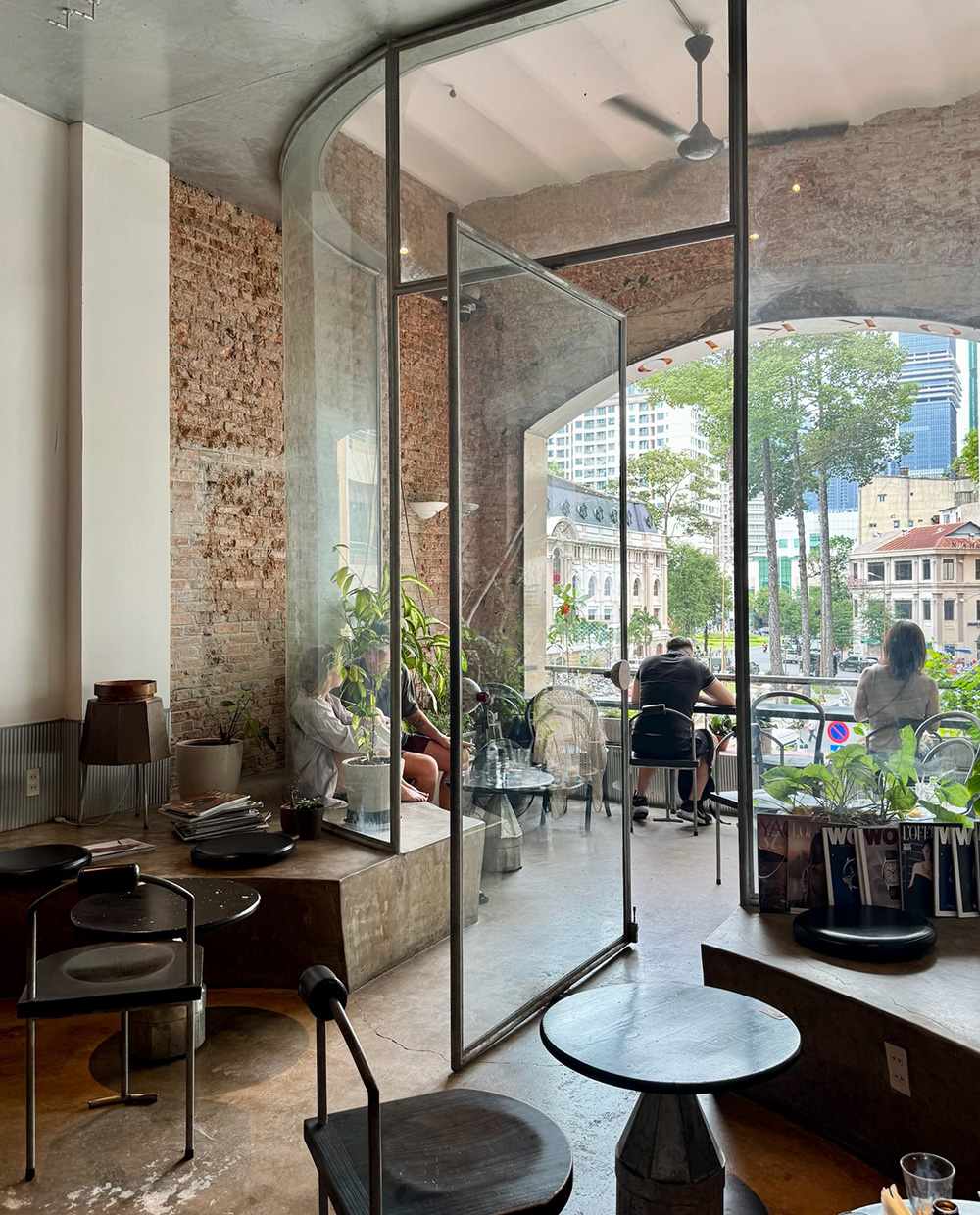

THE OLD COMPASS CAFÉ
Tucked away down a discreet alley, The Old Compass Café is a hidden gem that feels like stepping into a bygone era of Saigon. The space exudes faded colonial charm, with weathered wooden floors, vintage maps and bookshelves lining the walls. More than just a café, it’s also a cultural hub, hosting talks, live music, and storytelling nights that bring together locals and travellers alike. A quiet refuge with character and soul, The Old Compass is where history and modern Saigon meet over a perfectly brewed cup.



THE WORKSHOP
Tucked inside a restored colonial building, The Workshop is a specialty coffee haven, where industrial-chic design meets serious craftsmanship. The focus here is on meticulously brewed coffee, with a rotating selection of single-origin beans and a range of brewing methods, from pour-over to siphon. We read about this place but didn’t have time to try it.
Drink
SOCIAL CLUB
Perched high above the city on the rooftop of Hotel des Arts, Social Club is one of Saigon’s most stylish cocktail bars, offering breathtaking skyline views alongside expertly crafted drinks. The interior is a blend of 1920s European elegance and modern sophistication, with dark wood, plush seating and vintage chandeliers. Outside, the rooftop bar and infinity pool provide one of the best sunset spots in the city, with DJs adding to the lively ambiance.
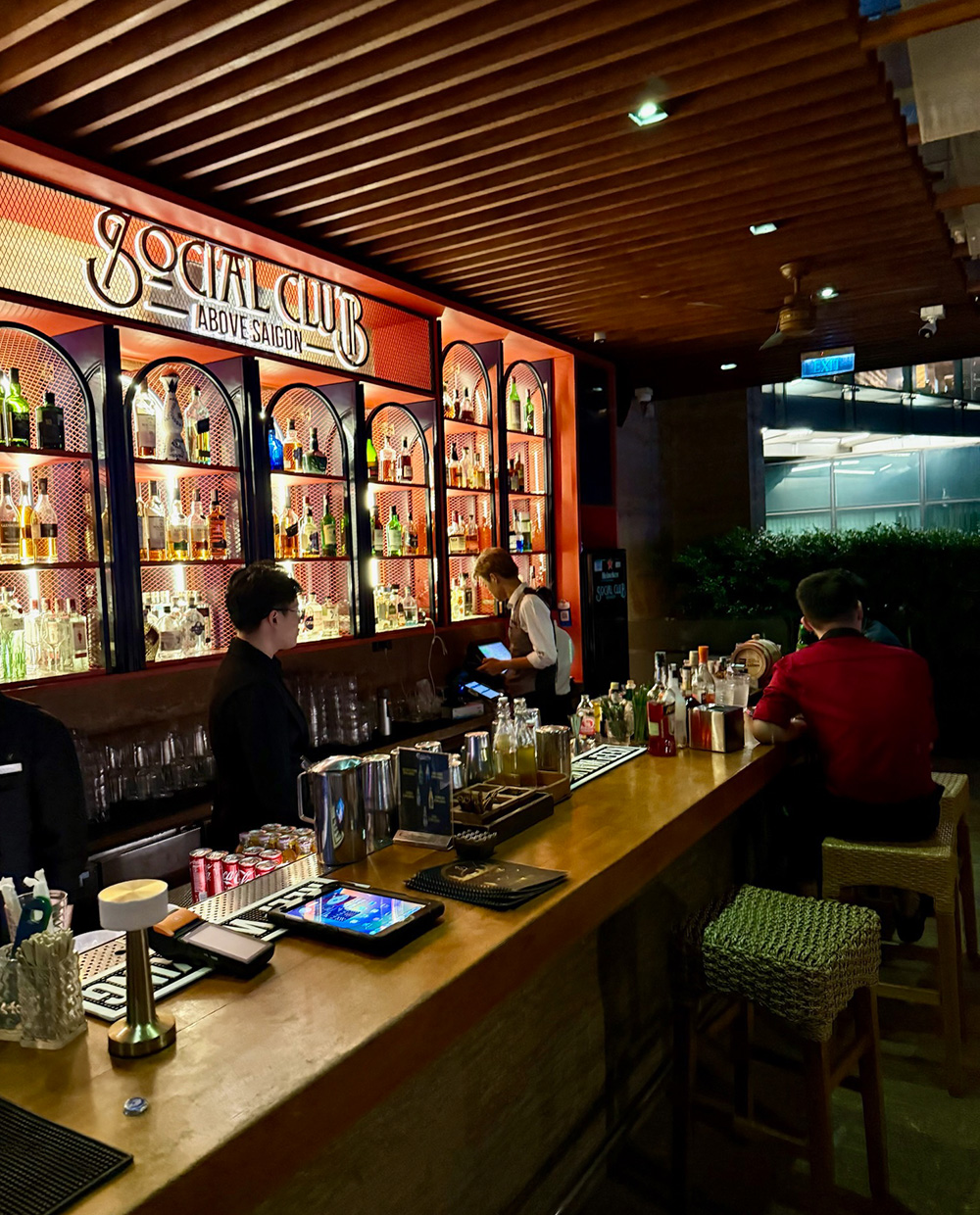

Zion Sky Lounge is another rooftop bar with panoramic views. It had a more sleek, modern and high-tech feel to it. A good spot for sunset drinks that turn into late-night beats with live DJs.

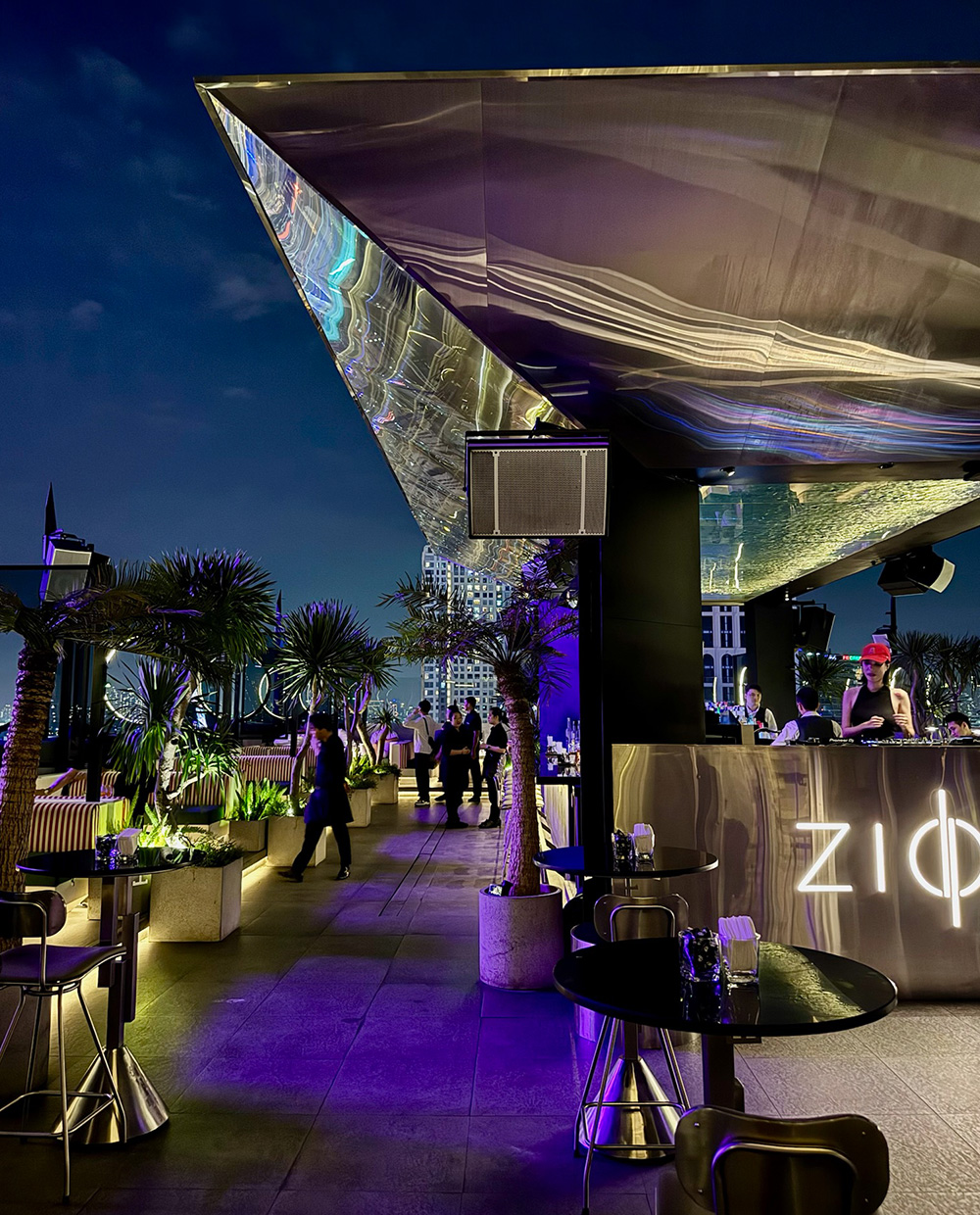

MADAME KEW
Hidden behind an unmarked door in a nondescript alleyway, Madame Kew is a sultry, Shanghai-inspired cocktail den that looks like you are stepping into a different era. Deep red velvet, dim lighting, and ornate Chinese-style décor set the mood for an intimate yet energetic space. The cocktail menu leans towards bold, Asian-infused flavours, with house specialties featuring ingredients like Sichuan peppercorn, lychee and Vietnamese herbs.
Dine
VESPA STREET FOOD TOUR
Riding through the electric streets of Saigon on the back of a vintage Vespa is about as thrilling as street food tours get! We did our tour with Vespa Adventures.
From the moment we hopped on, weaving through the city’s chaotic yet rhythmic traffic, the experience felt like stepping straight into the heartbeat of Saigon. Our expert local guides led us through hidden alleyways and bustling street corners, stopping at some local spots in town we might never have found on our own. The night ended with live music at a hidden bar, the perfect finale to an unforgettable ride through the flavours of Saigon.


NEN LIGHT
Tucked away in a quiet alley of Ho Chi Minh City, Nén Light is a world apart from the neon-lit chaos of its surroundings. The dim, atmospheric glow of the interior creates an intimate ambiance. This is the new home of chef Summer Le, a passionate advocate for Vietnam’s Central cuisine, who first made her mark in Danang before bringing her innovative culinary philosophy to Saigon.
Dining at Nén Light is more than just a meal—it’s a story-driven experience. The seven to nine-course ‘Sto:ry Menu’ is a masterclass in visual storytelling, with dishes that are both artful and deeply rooted in local traditions. Vegetarians are thoughtfully catered for with an equally intricate menu. The service is as refined as the food: attentive yet unobtrusive, ensuring that every course flows seamlessly into the next. At Nén Light, Summer Le isn’t just cooking, she’s sharing Vietnam’s stories, one beautifully plated dish at a time. One of our favourite dining destinations on our trip.
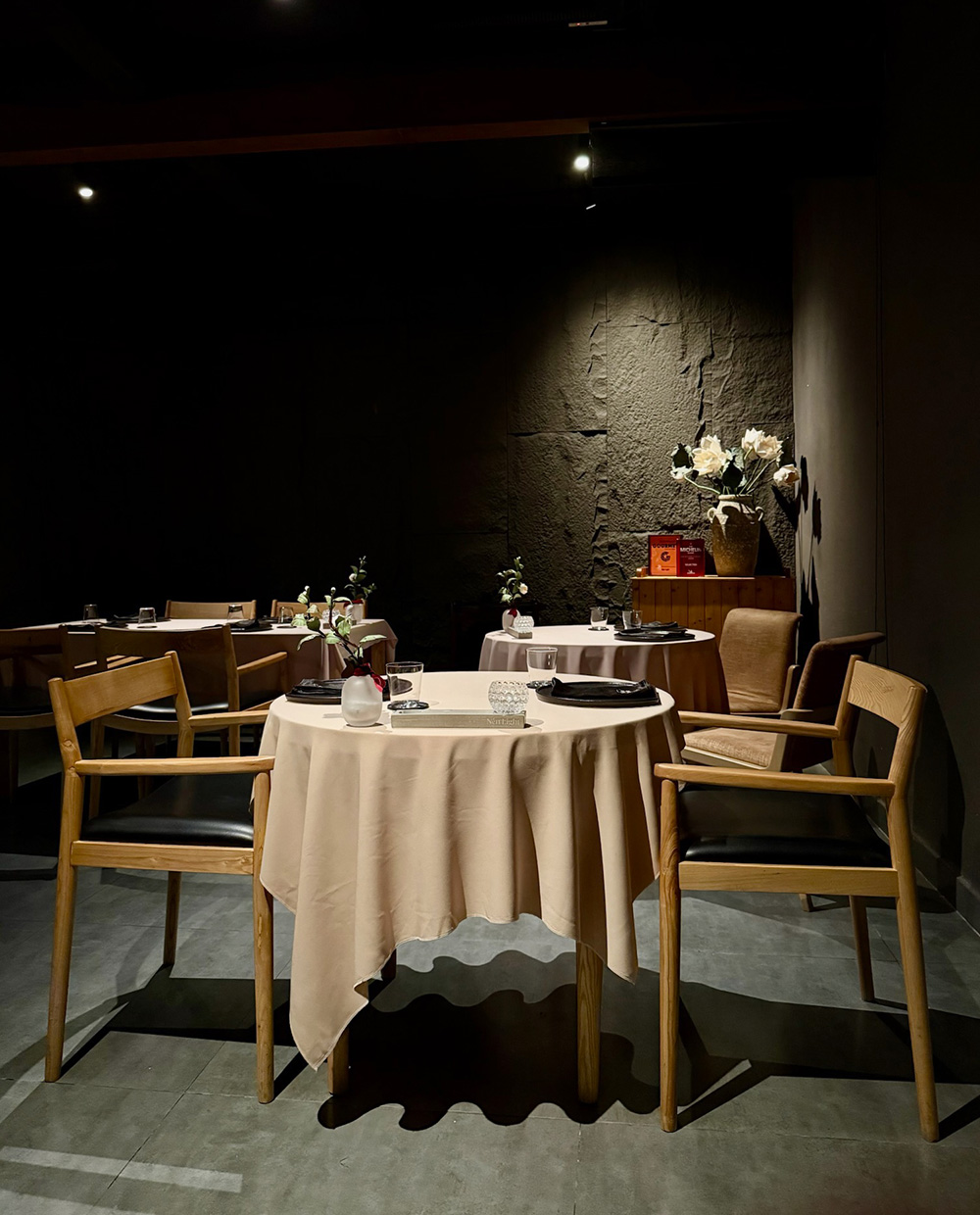

QUINCE
The combination of flavors and the lively, intimate setting made Quince a spot we would have loved to try, but with time against us, we had to add it to our list for next time. It is set inside a refurbished colonial house. The menu promises a mix of charcoal-grilled, wood-fired and oven-baked dishes, each with a subtle Asian twist.
PROPAGANDA
Recommended by our local tour agency, Propaganda Bistro sounded like a good spot for a more informal, casual dining experience. The vibrant eatery is known for its modern take on Vietnamese street food, served in a lively space decorated with bold, colourful propaganda-style murals.
Brunch or lunch
Industrial-chic meets effortless style at L’Usine, where a midday bite can be followed by a slow browse through curated selection of fashion and accessories. There are several outposts throughout the city, including the one we stopped off at in the Saigon Centre department store.


Shop
THE CAFÉ APARTMENT
One of Saigon’s most unique landmarks, the Café Apartment on Nguyen Hue Walking Street is a nine-story vertical maze of coffee shops, boutiques and creative spaces, each with its own personality. Originally built as housing for U.S. Army officers during the Vietnam War, the building has since been transformed into a bustling commercial hub. Our favourite spot was the Goốm Sài Gòn café and pottery store on the 2nd floor (below middle and right)
We spent a good hours here, browsing through local designer boutiques and enjoying a a coffee on a balcony view of the city’s buzz. While there is a small elevator, we opted for the stairs: a great way to ticking off a good portion of our 10,000 daily steps!



VINTAGE STORES
The Taylor girls had fun discovering vintage clothing shops like Bliss Vintage, often hidden up staircases. You may need to look carefully to find the entrance (see below right for the example of Bliss!). Some of the other stores our daughters found included Mayhem and Vintage Hearts.
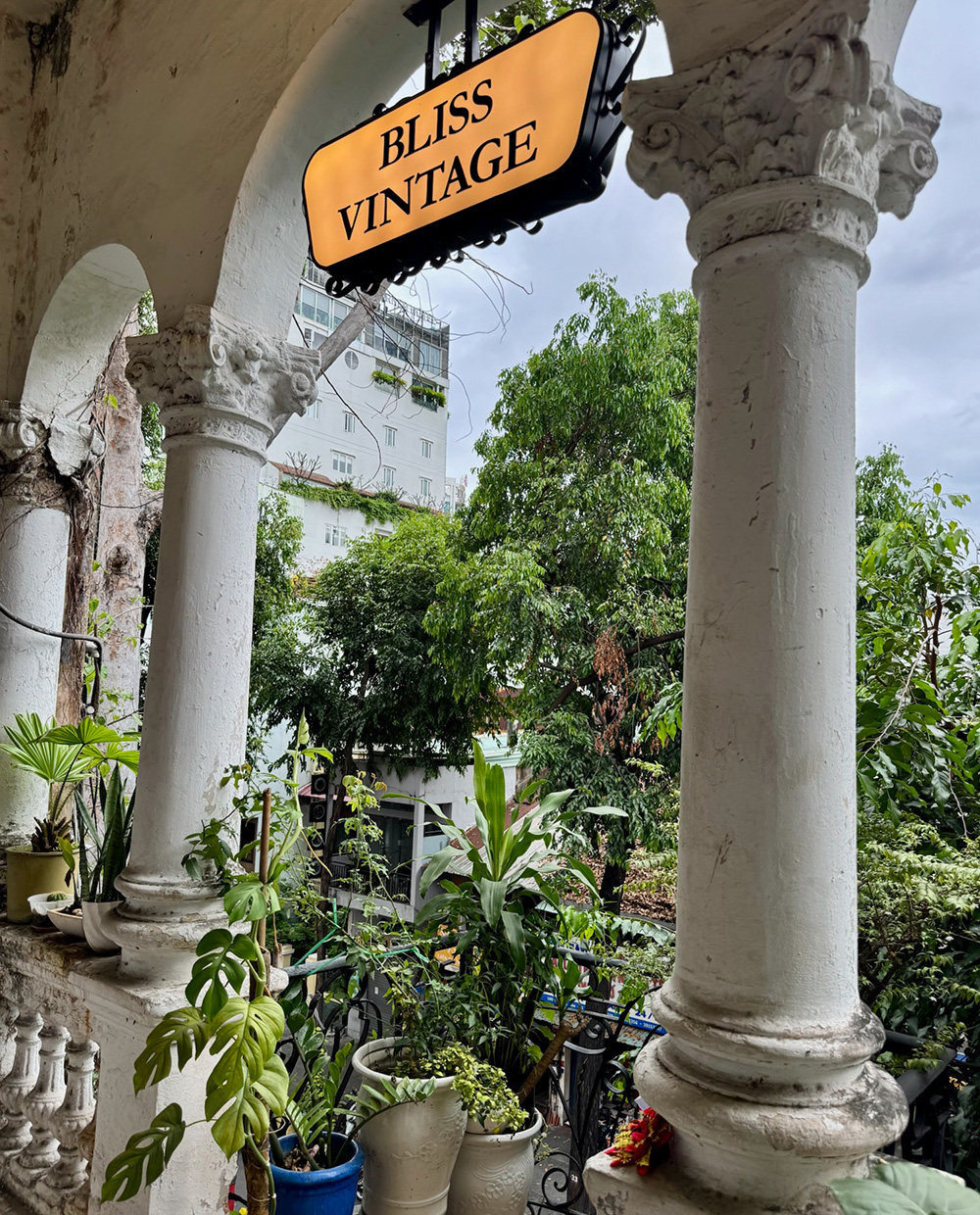

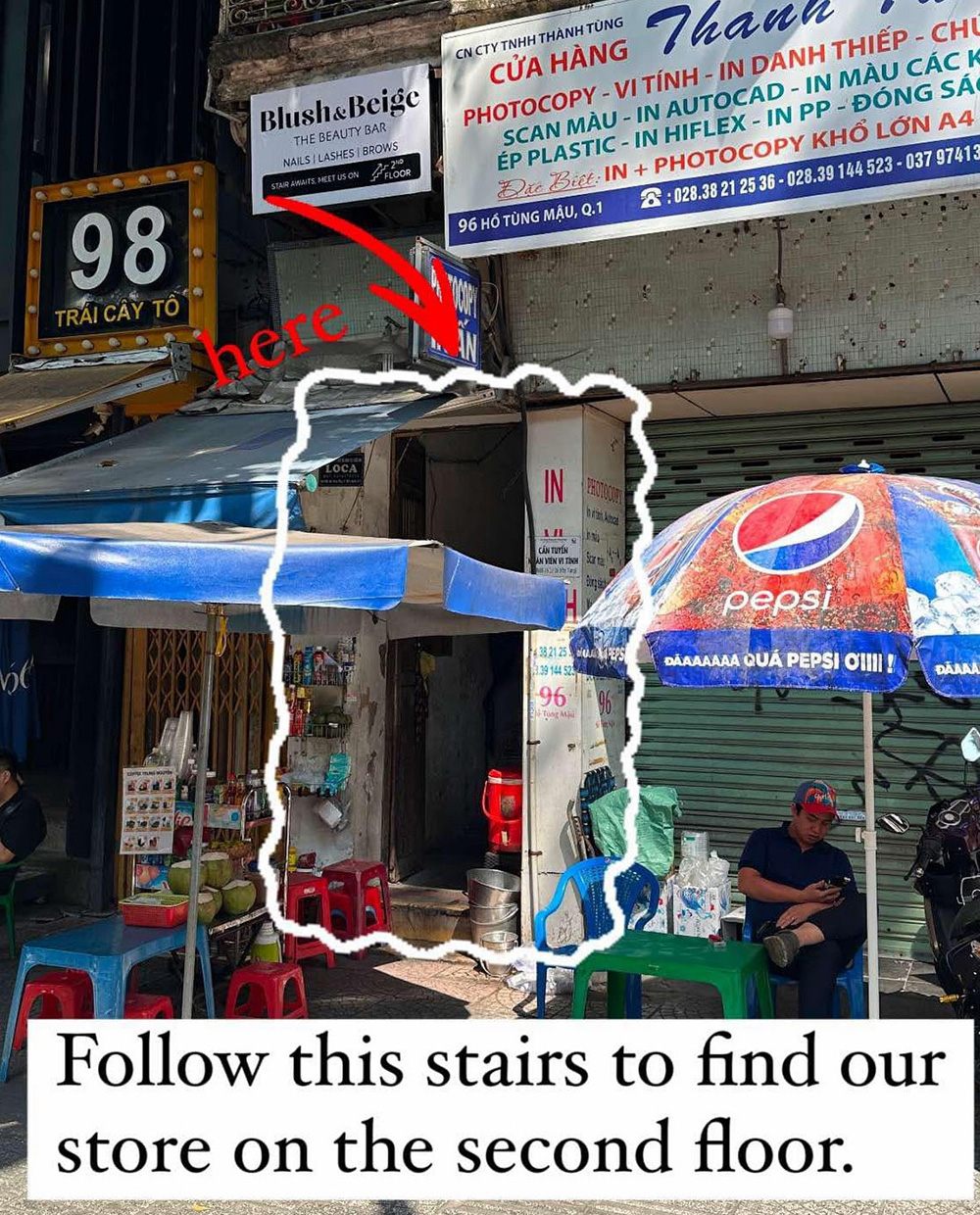
GINKO
GINKO is a Vietnamese clothing brand known for its sustainable, eco-friendly approach to fashion, offering high-quality cotton apparel and accessories with unique designs inspired by Vietnam’s culture.
THE NEW PLAYGROUND
The New Playground underground warren of streetwear shops, offers a fascinating vignette of Saigon’s youth culture. A good spot if you’re travelling with teens or young adults!
Ninh Van Bay: Six Senses
After 10 days exploring Vietnam’s bustling cities and cultural gems, we ended our journey with some well-earned relaxation. A short flight from Ho Chi Minh City, followed by a one-hour car transfer and short boat ride, brought us to Six Senses Ninh Van Bay. This secluded, tropical haven is nestled between dramatic jungle-clad hills and the emerald-green waters of the bay. The resort blends rustic charm with barefoot luxury, with weathered wood, stone and thatched roofs.

Stay
Six Senses Ninh Van Bay is an all-villa resort. Every villa enjoys sweeping sea vistas, private pools, outdoor showers and open-air living spaces.
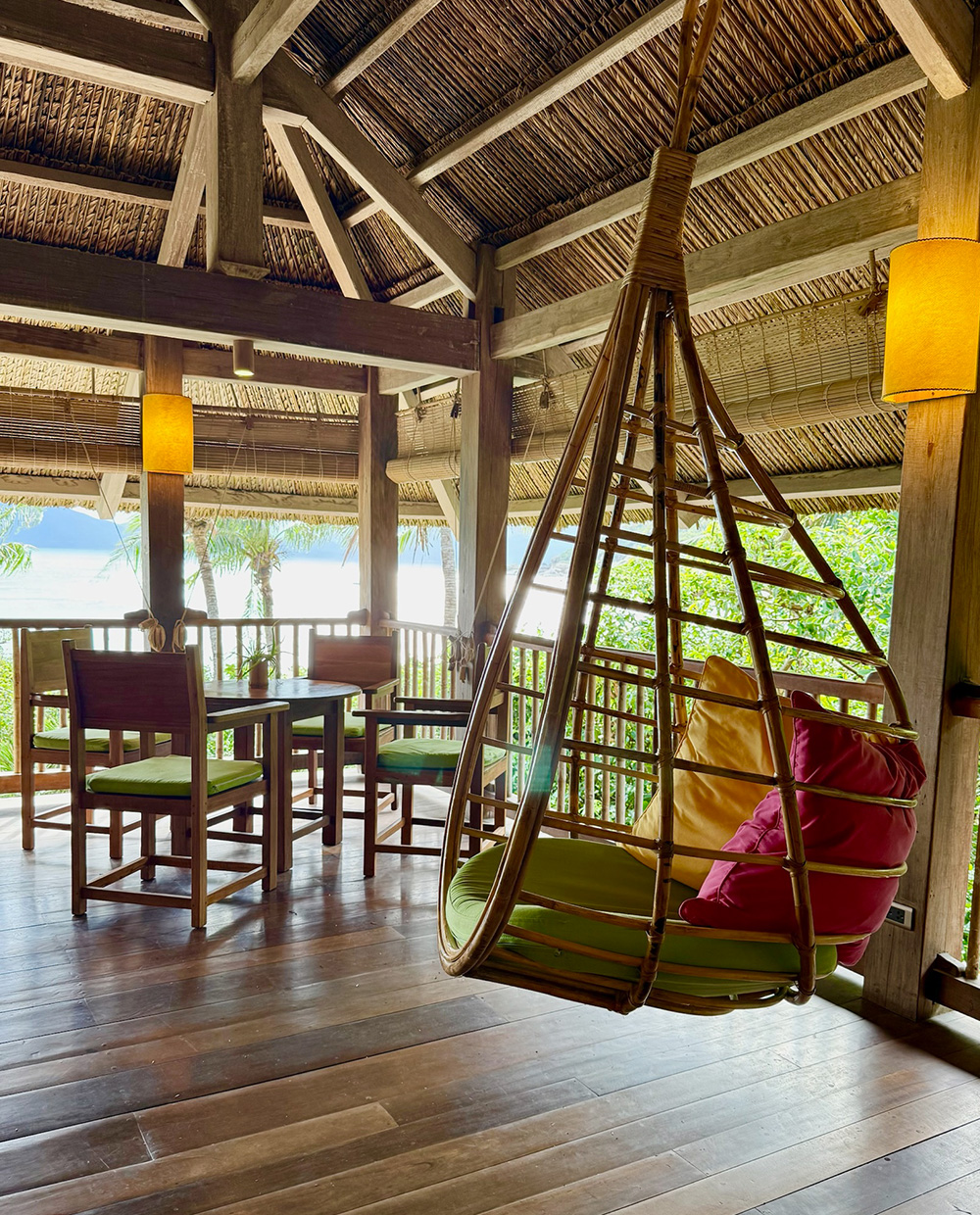

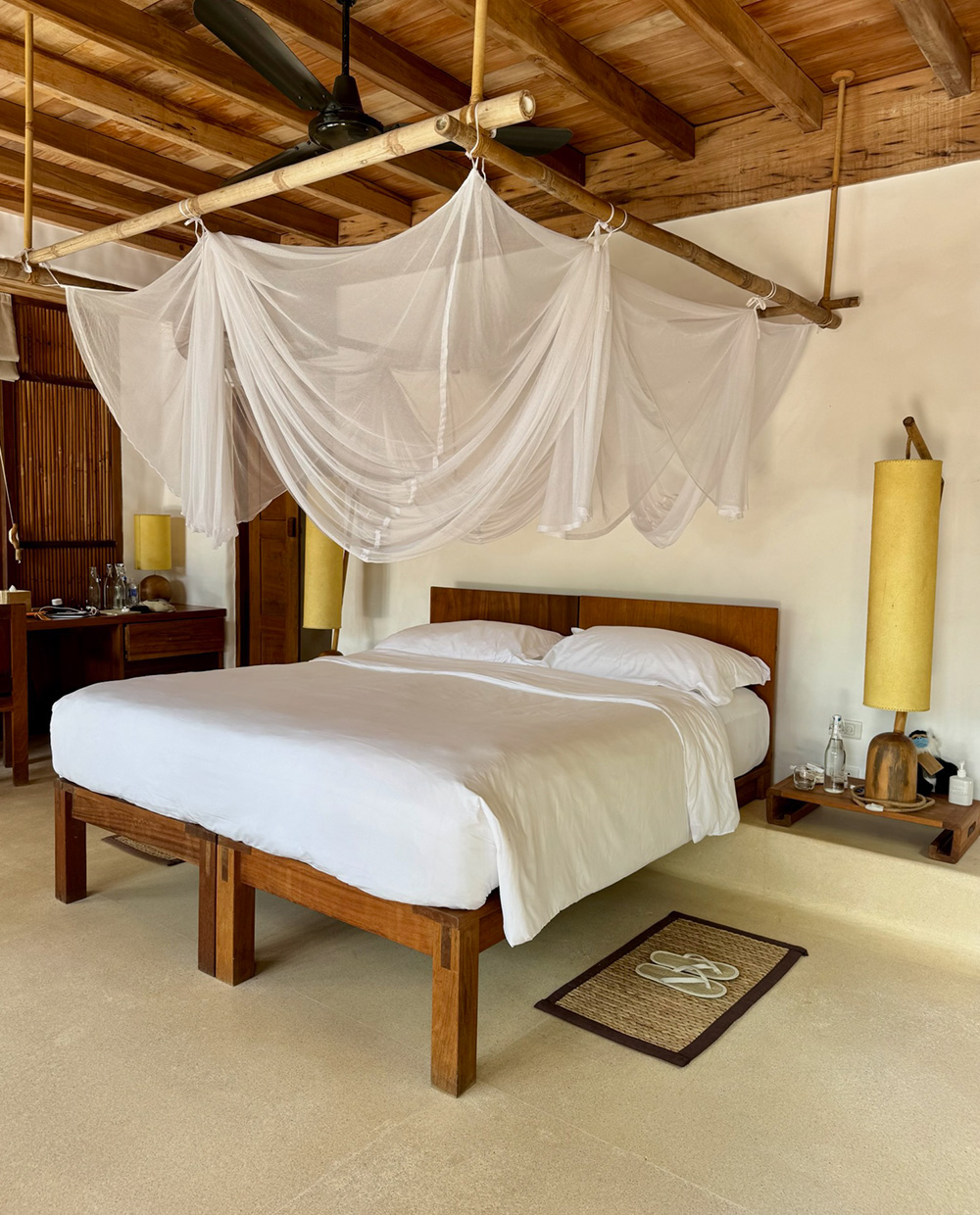
Some, like ours, sit directly on the beachfront, just steps from the sand, while others perch high on the hillside, offering spectacular panoramic views.



One of the standout features of Six Senses Ninh Van Bay is the service. Each villa comes with a Guest Experience Manager (GEM) who ensures that every detail of your stay is seamless. Whether arranging a private boat excursion, setting up a beachside dinner or simply making sure you have everything you need, the staff meet your needs with warmth and genuine hospitality.
The resort’s main pool overlooks the bay and is close to the beach. It never felt crowded, given that many guests prefer to lounge by their own private pools.
While the resort has a stunning setting, we did feel that it is starting to show its age. The rustic charm is part of the appeal, but it maybe time for a bit of a revamp?!
Dine
Three distinct restaurants offer a mix of flavors and atmospheres. By the Bay is the all-day dining spot, serving a generous breakfast spread and fresh Vietnamese-inspired dishes with great views of the bay.
By the Rocks is more intimate, perched on the hillside with spectacular sunset views, perfect for a romantic dinner. During our stay it was only open for set-menu dinners which while delicious were expensive (£100 per head at the time of writing ).
Meanwhile, By the Pool is a casual spot for light bites, ice creams and refreshing cocktails throughout the day. For sundowners, we loved the By the Beach bar, where we sipped cocktails with views of the sky turning pink and gold.

Do
For those looking to do more than just lounge by the sea, Six Senses Ninh Van Bay, complimentary options include paddleboarding and kayaking. For a bit more adrenaline, guests can try water skiing or
wakeboarding, available for an additional charge. The resort also offers sailing excursions, whether you want to take a lesson or simply enjoy a leisurely cruise around the bay.
A range of complimentary daily activities included Tai Chi sessions and hands-on workshops like coconut oil making and how to give a head massage.
No Six Senses experience is complete without a visit to the spa, and this one is truly special. Hidden within the jungle, the treatment rooms feel completely immersed in nature. For those who prefer to keep active, the gym boasts what might be one of the best workout views in the world. Floor-to-ceiling windows overlook the ocean, making it (almost) enjoyable to break a sweat!

Why a trip to Vietnam?
A trip to Vietnam is a journey through bustling cities, breathtaking landscapes, and bold flavours, where history, culture, and adventure collide. It offers an experience that is vibrant, immersive and unforgettable. Above all, the kindness, friendliness and warmth of the Vietnamese people stays in our memories and our hearts.